

Compact Muon Solenoid
LHC, CERN
| CMS-PAS-EXO-21-006 | ||
| Search for long-lived particles decaying to a pair of muons in proton-proton collisions at √s= 13 TeV | ||
| CMS Collaboration | ||
| January 2022 | ||
| Abstract: An inclusive search for long-lived exotic particles decaying to a pair of muons is presented. The search uses a data set collected by the CMS experiment at the LHC in proton-proton collisions at √s= 13 TeV in 2016 and 2018 and corresponding to an integrated luminosity of 97.6 fb−1. The experimental signature is a pair of oppositely charged muons originating from a common secondary vertex spatially separated from the proton interaction point by distances ranging from several hundred μm to several meters. The results are interpreted in the frameworks of the Hidden Abelian Higgs model, in which the Higgs boson decays to a pair of long-lived dark photons, and of a simplified model, in which long-lived particles are produced in decays of an exotic heavy neutral scalar boson. | ||
|
Links:
CDS record (PDF) ;
CADI line (restricted) ;
These preliminary results are superseded in this paper, JHEP 05 (2023) 228. The superseded preliminary plots can be found here. |
||
| Figures | Summary | Additional Figures & Tables | References | CMS Publications |
|---|
| Figures | |
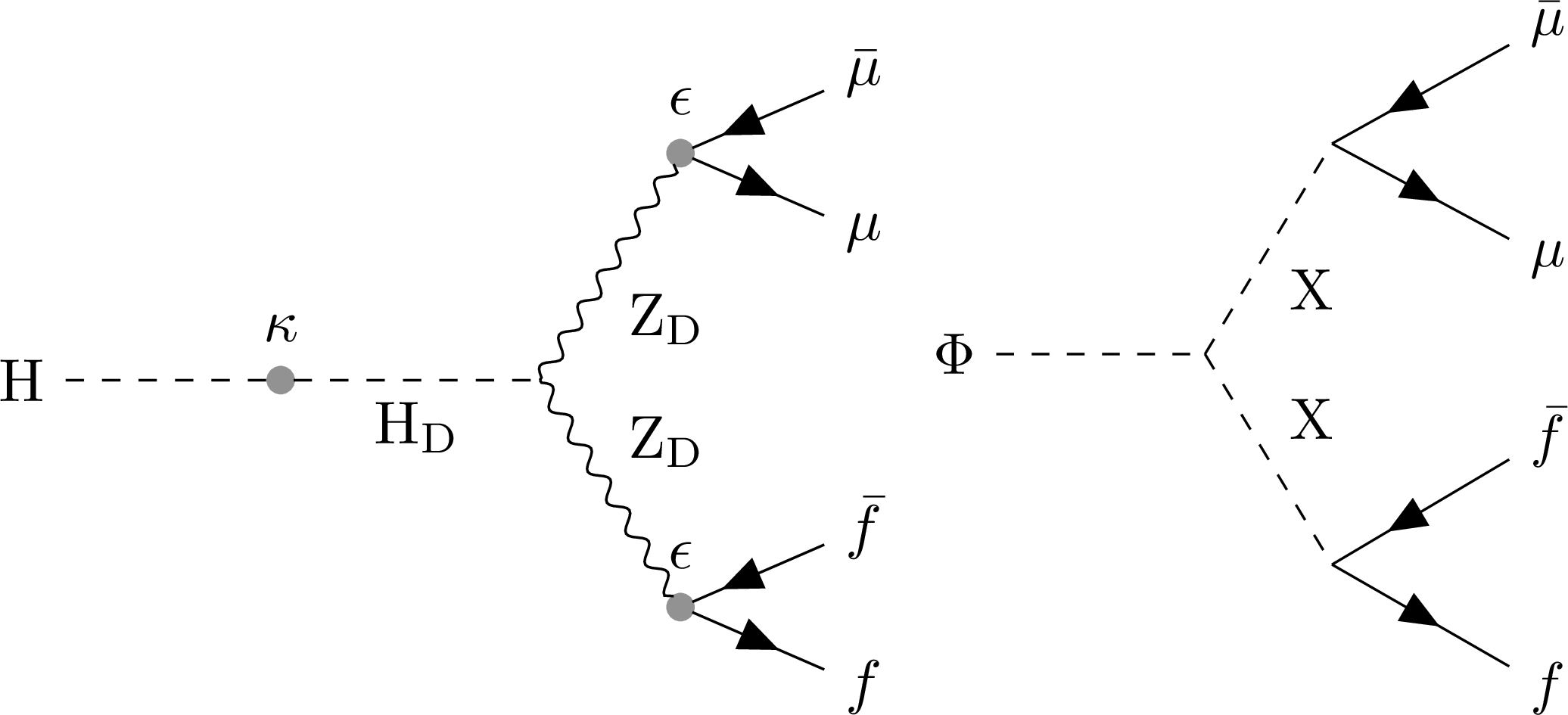
png pdf |
Figure 1:
Feynman diagrams of (left) the HAHM model, showing the production of ZD via the Higgs portal with the subsequent ZD decays via the vector portal, and (right) the heavy scalar model. The symbols f and ˉf represent, respectively, fermions and antifermions lighter than half the LLP mass. |

png pdf |
Figure 1-a:
Feynman diagrams of (left) the HAHM model, showing the production of ZD via the Higgs portal with the subsequent ZD decays via the vector portal, and (right) the heavy scalar model. The symbols f and ˉf represent, respectively, fermions and antifermions lighter than half the LLP mass. |
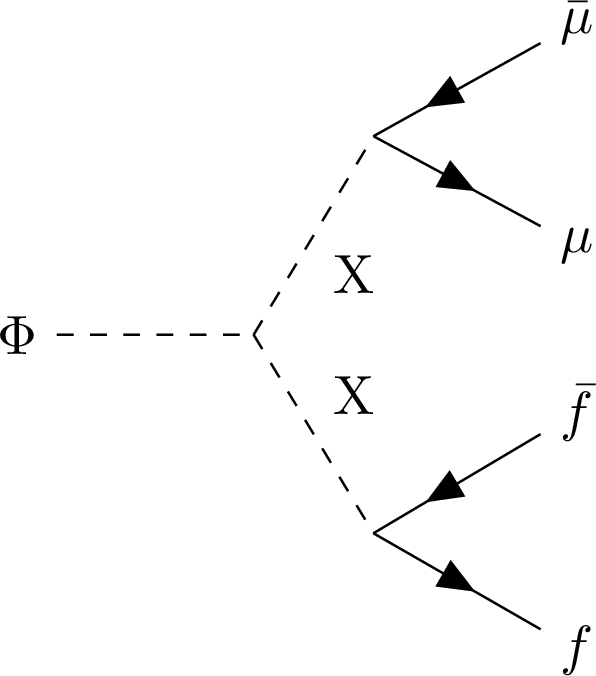
png pdf |
Figure 1-b:
Feynman diagrams of (left) the HAHM model, showing the production of ZD via the Higgs portal with the subsequent ZD decays via the vector portal, and (right) the heavy scalar model. The symbols f and ˉf represent, respectively, fermions and antifermions lighter than half the LLP mass. |

png pdf |
Figure 2:
Level-1 muon trigger efficiency in cosmic ray muon data (blue) and signal simulation (green) as a function of d0, for the Level-1 trigger pT thresholds used in the (left) 2016 and (right) 2018 analysis triggers. The denominator in the efficiency calculations is the number of STA muons with |η|< 1.2 and pT> 33 GeV (left) and 28 GeV (right). |

png pdf root |
Figure 2-a:
Level-1 muon trigger efficiency in cosmic ray muon data (blue) and signal simulation (green) as a function of d0, for the Level-1 trigger pT thresholds used in the (left) 2016 and (right) 2018 analysis triggers. The denominator in the efficiency calculations is the number of STA muons with |η|< 1.2 and pT> 33 GeV (left) and 28 GeV (right). |

png pdf root |
Figure 2-b:
Level-1 muon trigger efficiency in cosmic ray muon data (blue) and signal simulation (green) as a function of d0, for the Level-1 trigger pT thresholds used in the (left) 2016 and (right) 2018 analysis triggers. The denominator in the efficiency calculations is the number of STA muons with |η|< 1.2 and pT> 33 GeV (left) and 28 GeV (right). |

png pdf root |
Figure 3:
Fractions of signal events with zero (green), one (blue), and two (red) STA muons matched to TMS muons by the STA-to-TMS muon association procedure, as a function of true Lxy, in all simulated Φ→2X→2μ signal samples combined. The fractions are computed relative to the number of signal events passing the trigger and containing two STA muons with more than 12 muon hits and pT> 10 GeV matched to generated muons from X→μμ decays. |

png pdf |
Figure 4:
Distributions of |ΔΦ| for (left) STA-STA and (right) STA-TMS dimuons in 2018 data (black dots) and simulated background processes (stacked histograms), for events in the control regions with the STA to TMS association of the STA muons reversed as described in the text. All nominal selection requirements, including dimuon Lxy/σLxy and TMS muon d0/σd0, are applied to the STA-STA and STA-TMS dimuons. The simulated processes are scaled to correspond to the luminosity of the data. |
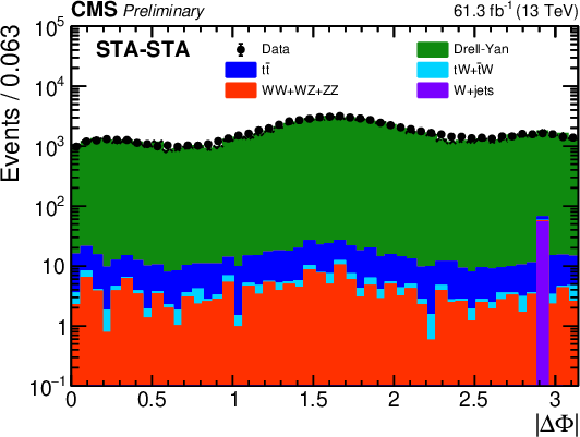
png pdf root |
Figure 4-a:
Distributions of |ΔΦ| for (left) STA-STA and (right) STA-TMS dimuons in 2018 data (black dots) and simulated background processes (stacked histograms), for events in the control regions with the STA to TMS association of the STA muons reversed as described in the text. All nominal selection requirements, including dimuon Lxy/σLxy and TMS muon d0/σd0, are applied to the STA-STA and STA-TMS dimuons. The simulated processes are scaled to correspond to the luminosity of the data. |
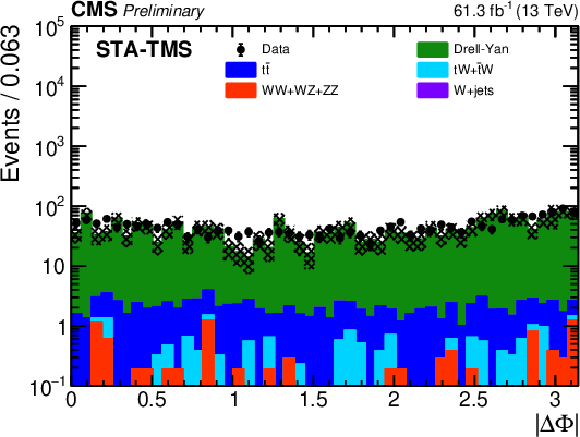
png pdf root |
Figure 4-b:
Distributions of |ΔΦ| for (left) STA-STA and (right) STA-TMS dimuons in 2018 data (black dots) and simulated background processes (stacked histograms), for events in the control regions with the STA to TMS association of the STA muons reversed as described in the text. All nominal selection requirements, including dimuon Lxy/σLxy and TMS muon d0/σd0, are applied to the STA-STA and STA-TMS dimuons. The simulated processes are scaled to correspond to the luminosity of the data. |

png pdf |
Figure 5:
Distributions of (left) |ΔΦ∗| (defined in the legend) of STA-STA dimuons and (right) mμμ of TMS-TMS dimuons associated with STA-STA dimuons. Both distributions show STA-STA dimuons in 2018 data in the control region enriched in QCD events, as described in the text. In the left plot, exactly one STA muon is associated with a TMS muon, while in the right plot, both are. All nominal selection requirements, including mμμ> 10 GeV and Lxy/σLxy> 6, are applied to the STA-STA dimuons. |
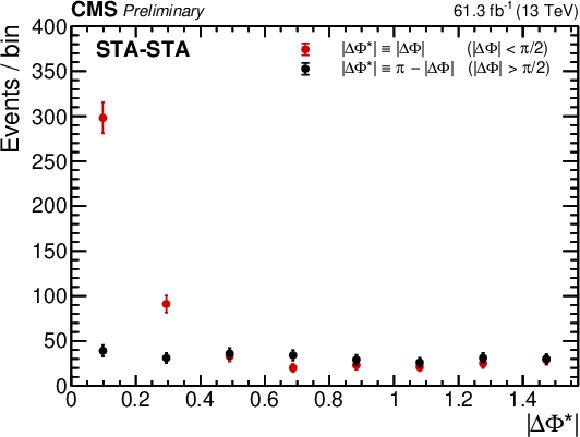
png pdf root |
Figure 5-a:
Distributions of (left) |ΔΦ∗| (defined in the legend) of STA-STA dimuons and (right) mμμ of TMS-TMS dimuons associated with STA-STA dimuons. Both distributions show STA-STA dimuons in 2018 data in the control region enriched in QCD events, as described in the text. In the left plot, exactly one STA muon is associated with a TMS muon, while in the right plot, both are. All nominal selection requirements, including mμμ> 10 GeV and Lxy/σLxy> 6, are applied to the STA-STA dimuons. |

png pdf root |
Figure 5-b:
Distributions of (left) |ΔΦ∗| (defined in the legend) of STA-STA dimuons and (right) mμμ of TMS-TMS dimuons associated with STA-STA dimuons. Both distributions show STA-STA dimuons in 2018 data in the control region enriched in QCD events, as described in the text. In the left plot, exactly one STA muon is associated with a TMS muon, while in the right plot, both are. All nominal selection requirements, including mμμ> 10 GeV and Lxy/σLxy> 6, are applied to the STA-STA dimuons. |
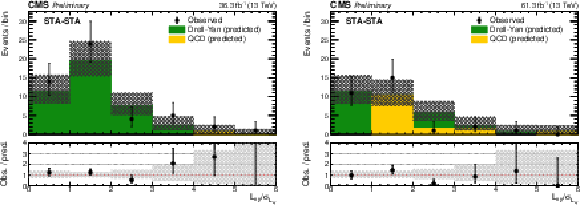
png pdf |
Figure 6:
Distributions of Lxy/σLxy of STA-STA dimuons in the Lxy/σLxy< 6 VR, in (left) 2016 and (right) 2018 data, compared to the background predictions. The observed distributions (black circles) are overlayed on stacked histograms containing the expected numbers of DY (green) and QCD (yellow) background events. The lower panels show the ratio of the observed to predicted numbers of events. Shaded area shows the statistical uncertainty in the background prediction. |

png pdf root |
Figure 6-a:
Distributions of Lxy/σLxy of STA-STA dimuons in the Lxy/σLxy< 6 VR, in (left) 2016 and (right) 2018 data, compared to the background predictions. The observed distributions (black circles) are overlayed on stacked histograms containing the expected numbers of DY (green) and QCD (yellow) background events. The lower panels show the ratio of the observed to predicted numbers of events. Shaded area shows the statistical uncertainty in the background prediction. |

png pdf root |
Figure 6-b:
Distributions of Lxy/σLxy of STA-STA dimuons in the Lxy/σLxy< 6 VR, in (left) 2016 and (right) 2018 data, compared to the background predictions. The observed distributions (black circles) are overlayed on stacked histograms containing the expected numbers of DY (green) and QCD (yellow) background events. The lower panels show the ratio of the observed to predicted numbers of events. Shaded area shows the statistical uncertainty in the background prediction. |

png pdf |
Figure 7:
Distributions of Lxy/σLxy of TMS-TMS dimuons in the 2 <min(d0/σd0)< 6 VR, in (left) 2016 and (right) 2018 data, compared to the background predictions. The observed distributions (black circles) are overlayed on stacked histograms containing the expected numbers of DY (green) and QCD (yellow) background events. The last bin includes events in the overflow. The lower panels show the ratio of the observed to predicted numbers of events. Shaded area shows the statistical uncertainty in the background prediction. |
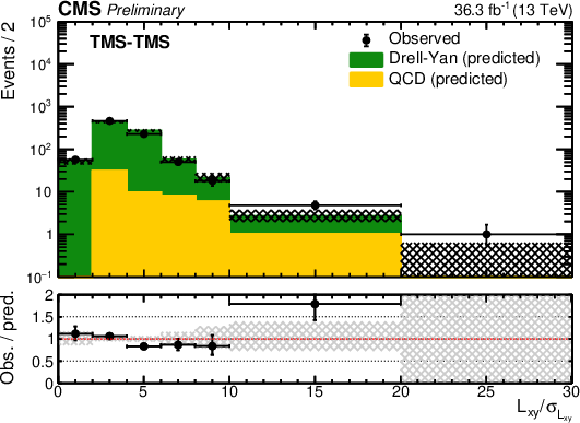
png pdf root |
Figure 7-a:
Distributions of Lxy/σLxy of TMS-TMS dimuons in the 2 <min(d0/σd0)< 6 VR, in (left) 2016 and (right) 2018 data, compared to the background predictions. The observed distributions (black circles) are overlayed on stacked histograms containing the expected numbers of DY (green) and QCD (yellow) background events. The last bin includes events in the overflow. The lower panels show the ratio of the observed to predicted numbers of events. Shaded area shows the statistical uncertainty in the background prediction. |
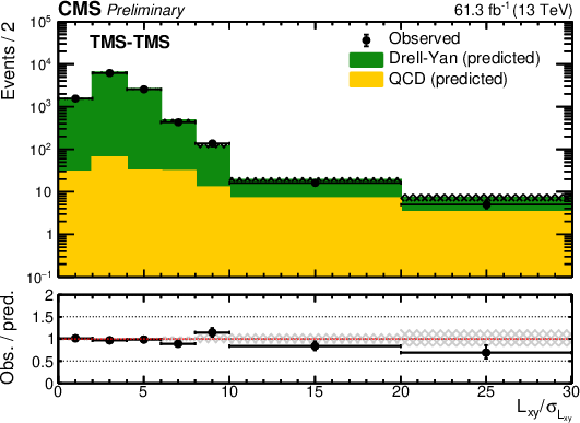
png pdf root |
Figure 7-b:
Distributions of Lxy/σLxy of TMS-TMS dimuons in the 2 <min(d0/σd0)< 6 VR, in (left) 2016 and (right) 2018 data, compared to the background predictions. The observed distributions (black circles) are overlayed on stacked histograms containing the expected numbers of DY (green) and QCD (yellow) background events. The last bin includes events in the overflow. The lower panels show the ratio of the observed to predicted numbers of events. Shaded area shows the statistical uncertainty in the background prediction. |

png pdf root |
Figure 8:
Comparison of observed (black circles) and predicted (histograms) yields of STA-STA dimuons in the validation regions enriched in QCD background events. The first bin shows the yields in the low-mass VR in 2018 data. The other three groups of bins, separated by solid lines, show the yields in the small-|Δημμ| VR, in (from left to right) the entire 2018 data set, a subset of 2018 data enriched in events collected in 2016, and the 2016 data set. Each of these three VRs is further subdivided into three mμμ intervals, 10-32, 15-60, and 20-80 GeV. The expected number of background events is computed according to Eqs. (3) and (4), separately in each mμμ bin. Shaded area shows the statistical uncertainty in the background prediction. |
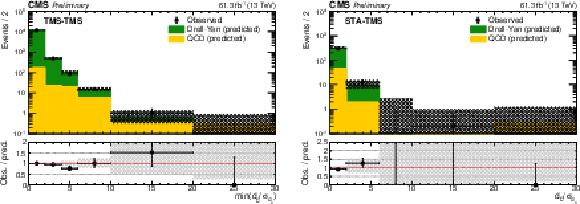
png pdf |
Figure 9:
Distributions in the π/4<|ΔΦ|<π/2 VR in 2018 data: (left) the smaller of the two d0/σd0 values in the TMS-TMS dimuon; (right) d0/σd0 of the TMS muon in the STA-TMS dimuon. The observed distributions (black circles) are compared to the results of the background prediction method applied to events with π/2<|ΔΦ|<3π/4. The stacked histograms show the expected numbers of DY (green) and QCD (yellow) background events. The last bin includes events in the overflow. The lower panels show the ratios of the observed to predicted numbers of events. Shaded area shows the statistical uncertainty in the background prediction. |

png pdf root |
Figure 9-a:
Distributions in the π/4<|ΔΦ|<π/2 VR in 2018 data: (left) the smaller of the two d0/σd0 values in the TMS-TMS dimuon; (right) d0/σd0 of the TMS muon in the STA-TMS dimuon. The observed distributions (black circles) are compared to the results of the background prediction method applied to events with π/2<|ΔΦ|<3π/4. The stacked histograms show the expected numbers of DY (green) and QCD (yellow) background events. The last bin includes events in the overflow. The lower panels show the ratios of the observed to predicted numbers of events. Shaded area shows the statistical uncertainty in the background prediction. |

png pdf root |
Figure 9-b:
Distributions in the π/4<|ΔΦ|<π/2 VR in 2018 data: (left) the smaller of the two d0/σd0 values in the TMS-TMS dimuon; (right) d0/σd0 of the TMS muon in the STA-TMS dimuon. The observed distributions (black circles) are compared to the results of the background prediction method applied to events with π/2<|ΔΦ|<3π/4. The stacked histograms show the expected numbers of DY (green) and QCD (yellow) background events. The last bin includes events in the overflow. The lower panels show the ratios of the observed to predicted numbers of events. Shaded area shows the statistical uncertainty in the background prediction. |
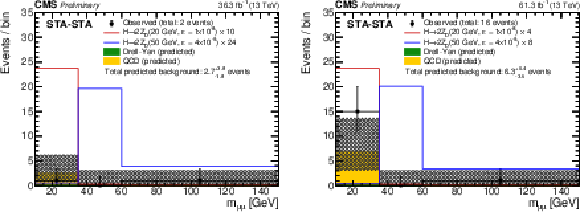
png pdf |
Figure 10:
Comparison between the number of events observed in (left) 2016 and (right) 2018 data in the STA-STA dimuon category with the expected number of background events, in representative mμμ intervals. The black circles show the number of observed events; the green and yellow components of the stacked histograms represent the estimated numbers of DY and QCD events, respectively. The last bin includes events in the overflow. The uncertainties in the total expected background (shaded area) are statistical only. Signal contributions expected from simulated H→ZDZD with m(ZD) of 20 and 50 GeV are shown in red and blue, respectively. Their yields are set to the corresponding median expected exclusion limits at 95% CL and scaled up to improve their visibility. The legends include the total number of observed events as well as the mμμ-integrated number of expected background events, which is obtained by applying the background evaluation method to the events in all mass intervals combined. |

png pdf root |
Figure 10-a:
Comparison between the number of events observed in (left) 2016 and (right) 2018 data in the STA-STA dimuon category with the expected number of background events, in representative mμμ intervals. The black circles show the number of observed events; the green and yellow components of the stacked histograms represent the estimated numbers of DY and QCD events, respectively. The last bin includes events in the overflow. The uncertainties in the total expected background (shaded area) are statistical only. Signal contributions expected from simulated H→ZDZD with m(ZD) of 20 and 50 GeV are shown in red and blue, respectively. Their yields are set to the corresponding median expected exclusion limits at 95% CL and scaled up to improve their visibility. The legends include the total number of observed events as well as the mμμ-integrated number of expected background events, which is obtained by applying the background evaluation method to the events in all mass intervals combined. |

png pdf root |
Figure 10-b:
Comparison between the number of events observed in (left) 2016 and (right) 2018 data in the STA-STA dimuon category with the expected number of background events, in representative mμμ intervals. The black circles show the number of observed events; the green and yellow components of the stacked histograms represent the estimated numbers of DY and QCD events, respectively. The last bin includes events in the overflow. The uncertainties in the total expected background (shaded area) are statistical only. Signal contributions expected from simulated H→ZDZD with m(ZD) of 20 and 50 GeV are shown in red and blue, respectively. Their yields are set to the corresponding median expected exclusion limits at 95% CL and scaled up to improve their visibility. The legends include the total number of observed events as well as the mμμ-integrated number of expected background events, which is obtained by applying the background evaluation method to the events in all mass intervals combined. |

png pdf |
Figure 11:
Comparison between the number of events observed in (left) 2016 and (right) 2018 data in the STA-TMS dimuon category with the expected number of background events, in representative mμμ intervals. The black circles show the number of observed events; the green and yellow components of the stacked histograms represent the estimated numbers of DY and QCD events, respectively. The last bin includes events in the overflow. The uncertainties in the total expected background (shaded area) are statistical only. Signal contributions expected from simulated H→ZDZD with m(ZD) of 30 and 60 GeV are shown in red and blue, respectively. Their yields are set to the corresponding median expected exclusion limits at 95% CL and scaled up to improve their visibility. The legends include the total number of observed events as well as the mμμ-integrated number of expected background events, which is obtained by applying the background evaluation method to the events in all mass intervals combined. |

png pdf root |
Figure 11-a:
Comparison between the number of events observed in (left) 2016 and (right) 2018 data in the STA-TMS dimuon category with the expected number of background events, in representative mμμ intervals. The black circles show the number of observed events; the green and yellow components of the stacked histograms represent the estimated numbers of DY and QCD events, respectively. The last bin includes events in the overflow. The uncertainties in the total expected background (shaded area) are statistical only. Signal contributions expected from simulated H→ZDZD with m(ZD) of 30 and 60 GeV are shown in red and blue, respectively. Their yields are set to the corresponding median expected exclusion limits at 95% CL and scaled up to improve their visibility. The legends include the total number of observed events as well as the mμμ-integrated number of expected background events, which is obtained by applying the background evaluation method to the events in all mass intervals combined. |

png pdf root |
Figure 11-b:
Comparison between the number of events observed in (left) 2016 and (right) 2018 data in the STA-TMS dimuon category with the expected number of background events, in representative mμμ intervals. The black circles show the number of observed events; the green and yellow components of the stacked histograms represent the estimated numbers of DY and QCD events, respectively. The last bin includes events in the overflow. The uncertainties in the total expected background (shaded area) are statistical only. Signal contributions expected from simulated H→ZDZD with m(ZD) of 30 and 60 GeV are shown in red and blue, respectively. Their yields are set to the corresponding median expected exclusion limits at 95% CL and scaled up to improve their visibility. The legends include the total number of observed events as well as the mμμ-integrated number of expected background events, which is obtained by applying the background evaluation method to the events in all mass intervals combined. |

png pdf |
Figure 12:
Comparison between the number of events observed in (left) 2016 and (right) 2018 data in the TMS-TMS dimuon category with the expected number of background events, in representative mμμ intervals. The black circles show the number of observed events; the green and yellow components of the stacked histograms represent the estimated numbers of DY and QCD events, respectively. The last bin includes events in the overflow. The uncertainties in the total expected background (shaded area) are statistical only. Signal contributions expected from simulated H→ZDZD with m(ZD) of 20 and 50 GeV are shown in red and blue, respectively. Their yields are set to the corresponding median expected exclusion limits at 95% CL and scaled up to improve their visibility. The legends include the total number of observed events as well as the mμμ-integrated number of expected background events, which is obtained by applying the background evaluation method to the events in all mass intervals combined. |

png pdf root |
Figure 12-a:
Comparison between the number of events observed in (left) 2016 and (right) 2018 data in the TMS-TMS dimuon category with the expected number of background events, in representative mμμ intervals. The black circles show the number of observed events; the green and yellow components of the stacked histograms represent the estimated numbers of DY and QCD events, respectively. The last bin includes events in the overflow. The uncertainties in the total expected background (shaded area) are statistical only. Signal contributions expected from simulated H→ZDZD with m(ZD) of 20 and 50 GeV are shown in red and blue, respectively. Their yields are set to the corresponding median expected exclusion limits at 95% CL and scaled up to improve their visibility. The legends include the total number of observed events as well as the mμμ-integrated number of expected background events, which is obtained by applying the background evaluation method to the events in all mass intervals combined. |
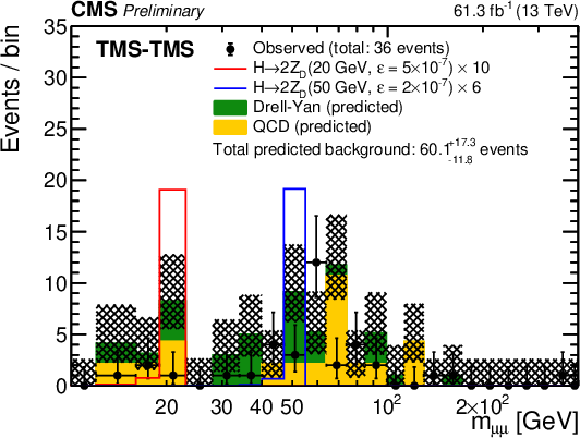
png pdf root |
Figure 12-b:
Comparison between the number of events observed in (left) 2016 and (right) 2018 data in the TMS-TMS dimuon category with the expected number of background events, in representative mμμ intervals. The black circles show the number of observed events; the green and yellow components of the stacked histograms represent the estimated numbers of DY and QCD events, respectively. The last bin includes events in the overflow. The uncertainties in the total expected background (shaded area) are statistical only. Signal contributions expected from simulated H→ZDZD with m(ZD) of 20 and 50 GeV are shown in red and blue, respectively. Their yields are set to the corresponding median expected exclusion limits at 95% CL and scaled up to improve their visibility. The legends include the total number of observed events as well as the mμμ-integrated number of expected background events, which is obtained by applying the background evaluation method to the events in all mass intervals combined. |

png pdf |
Figure 13:
Comparison between the number of events observed in (left) 2016 and (right) 2018 data in the TMS-TMS dimuon category with the expected number of background events, as a function of the smaller of the two d0/σd0 values in the TMS-TMS dimuon. The black circles show the number of observed events; the green and yellow components of the stacked histograms represent the estimated numbers of DY and QCD events, respectively. The last bin includes events in the overflow. The uncertainties in the total expected background (shaded area) are statistical only. Signal contributions expected from simulated H→ZDZD with m(ZD) of 20 and 50 GeV are shown in red and blue, respectively. Their yields are set to the corresponding median expected exclusion limits at 95% CL and scaled up to improve their visibility. |

png pdf root |
Figure 13-a:
Comparison between the number of events observed in (left) 2016 and (right) 2018 data in the TMS-TMS dimuon category with the expected number of background events, as a function of the smaller of the two d0/σd0 values in the TMS-TMS dimuon. The black circles show the number of observed events; the green and yellow components of the stacked histograms represent the estimated numbers of DY and QCD events, respectively. The last bin includes events in the overflow. The uncertainties in the total expected background (shaded area) are statistical only. Signal contributions expected from simulated H→ZDZD with m(ZD) of 20 and 50 GeV are shown in red and blue, respectively. Their yields are set to the corresponding median expected exclusion limits at 95% CL and scaled up to improve their visibility. |
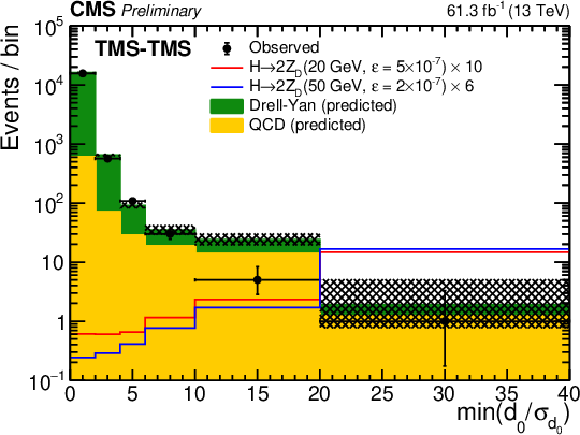
png pdf root |
Figure 13-b:
Comparison between the number of events observed in (left) 2016 and (right) 2018 data in the TMS-TMS dimuon category with the expected number of background events, as a function of the smaller of the two d0/σd0 values in the TMS-TMS dimuon. The black circles show the number of observed events; the green and yellow components of the stacked histograms represent the estimated numbers of DY and QCD events, respectively. The last bin includes events in the overflow. The uncertainties in the total expected background (shaded area) are statistical only. Signal contributions expected from simulated H→ZDZD with m(ZD) of 20 and 50 GeV are shown in red and blue, respectively. Their yields are set to the corresponding median expected exclusion limits at 95% CL and scaled up to improve their visibility. |

png pdf |
Figure 14:
The 95% CL upper limits on σ(Φ→XX)B(X→μμ) as a function of cτ(X) in the heavy scalar model, for m(Φ)= 125 GeV and (left) m(X)= 20 GeV and (right) m(X)= 50 GeV. The median expected limits obtained from the STA-STA, STA-TMS, and TMS-TMS dimuon categories are shown as dashed green, blue, and red curves, respectively; the combined median expected limits are shown as dashed black curves; the combined observed limits are shown as solid black curves. The green and the yellow bands correspond, respectively, to the 68% and 95% central quantiles for the combined expected limits. |
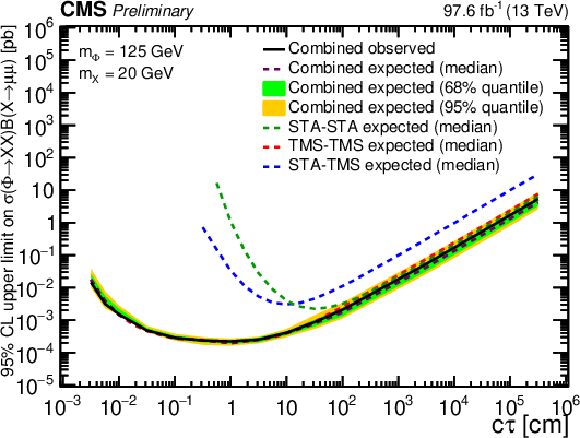
png pdf root |
Figure 14-a:
The 95% CL upper limits on σ(Φ→XX)B(X→μμ) as a function of cτ(X) in the heavy scalar model, for m(Φ)= 125 GeV and (left) m(X)= 20 GeV and (right) m(X)= 50 GeV. The median expected limits obtained from the STA-STA, STA-TMS, and TMS-TMS dimuon categories are shown as dashed green, blue, and red curves, respectively; the combined median expected limits are shown as dashed black curves; the combined observed limits are shown as solid black curves. The green and the yellow bands correspond, respectively, to the 68% and 95% central quantiles for the combined expected limits. |
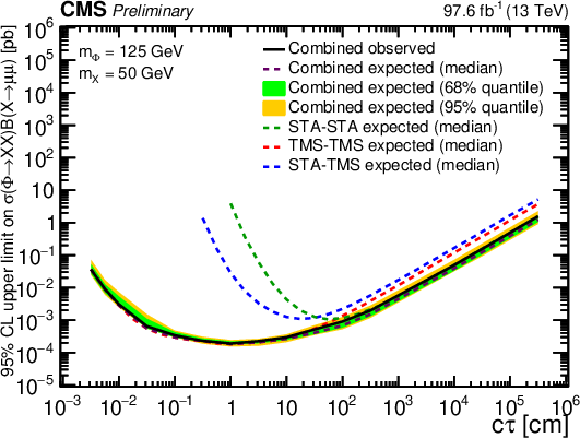
png pdf root |
Figure 14-b:
The 95% CL upper limits on σ(Φ→XX)B(X→μμ) as a function of cτ(X) in the heavy scalar model, for m(Φ)= 125 GeV and (left) m(X)= 20 GeV and (right) m(X)= 50 GeV. The median expected limits obtained from the STA-STA, STA-TMS, and TMS-TMS dimuon categories are shown as dashed green, blue, and red curves, respectively; the combined median expected limits are shown as dashed black curves; the combined observed limits are shown as solid black curves. The green and the yellow bands correspond, respectively, to the 68% and 95% central quantiles for the combined expected limits. |
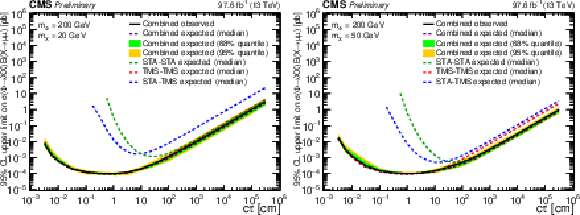
png pdf |
Figure 15:
The 95% CL upper limits on σ(Φ→XX)B(X→μμ) as a function of cτ(X) in the heavy scalar model, for m(Φ)= 200 GeV and (left) m(X)= 20 GeV and (right) m(X)= 50 GeV. The median expected limits obtained from the STA-STA, STA-TMS, and TMS-TMS dimuon categories are shown as dashed green, blue, and red curves, respectively; the combined median expected limits are shown as dashed black curves; the combined observed limits are shown as solid black curves. The green and the yellow bands correspond, respectively, to the 68% and 95% central quantiles for the combined expected limits. |

png pdf root |
Figure 15-a:
The 95% CL upper limits on σ(Φ→XX)B(X→μμ) as a function of cτ(X) in the heavy scalar model, for m(Φ)= 200 GeV and (left) m(X)= 20 GeV and (right) m(X)= 50 GeV. The median expected limits obtained from the STA-STA, STA-TMS, and TMS-TMS dimuon categories are shown as dashed green, blue, and red curves, respectively; the combined median expected limits are shown as dashed black curves; the combined observed limits are shown as solid black curves. The green and the yellow bands correspond, respectively, to the 68% and 95% central quantiles for the combined expected limits. |

png pdf root |
Figure 15-b:
The 95% CL upper limits on σ(Φ→XX)B(X→μμ) as a function of cτ(X) in the heavy scalar model, for m(Φ)= 200 GeV and (left) m(X)= 20 GeV and (right) m(X)= 50 GeV. The median expected limits obtained from the STA-STA, STA-TMS, and TMS-TMS dimuon categories are shown as dashed green, blue, and red curves, respectively; the combined median expected limits are shown as dashed black curves; the combined observed limits are shown as solid black curves. The green and the yellow bands correspond, respectively, to the 68% and 95% central quantiles for the combined expected limits. |
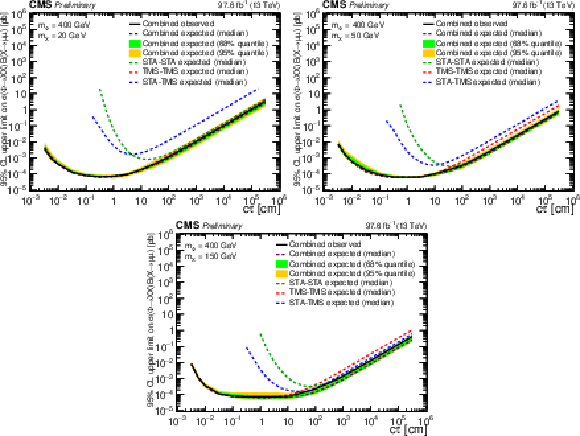
png pdf |
Figure 16:
The 95% CL upper limits on σ(Φ→XX)B(X→μμ) as a function of cτ(X) in the heavy scalar model, for m(Φ)= 400 GeV and (upper left) m(X)= 20 GeV, (upper right) m(X)= 50 GeV, and (lower) m(X)= 150 GeV. The median expected limits obtained from the STA-STA, STA-TMS, and TMS-TMS dimuon categories are shown as dashed green, blue, and red curves, respectively; the combined median expected limits are shown as dashed black curves; the combined observed limits are shown as solid black curves. The green and the yellow bands correspond, respectively, to the 68% and 95% quantiles for the combined expected limits. |
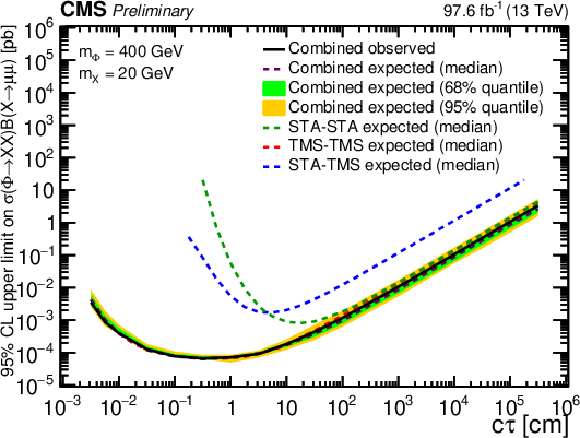
png pdf root |
Figure 16-a:
The 95% CL upper limits on σ(Φ→XX)B(X→μμ) as a function of cτ(X) in the heavy scalar model, for m(Φ)= 400 GeV and (upper left) m(X)= 20 GeV, (upper right) m(X)= 50 GeV, and (lower) m(X)= 150 GeV. The median expected limits obtained from the STA-STA, STA-TMS, and TMS-TMS dimuon categories are shown as dashed green, blue, and red curves, respectively; the combined median expected limits are shown as dashed black curves; the combined observed limits are shown as solid black curves. The green and the yellow bands correspond, respectively, to the 68% and 95% quantiles for the combined expected limits. |

png pdf root |
Figure 16-b:
The 95% CL upper limits on σ(Φ→XX)B(X→μμ) as a function of cτ(X) in the heavy scalar model, for m(Φ)= 400 GeV and (upper left) m(X)= 20 GeV, (upper right) m(X)= 50 GeV, and (lower) m(X)= 150 GeV. The median expected limits obtained from the STA-STA, STA-TMS, and TMS-TMS dimuon categories are shown as dashed green, blue, and red curves, respectively; the combined median expected limits are shown as dashed black curves; the combined observed limits are shown as solid black curves. The green and the yellow bands correspond, respectively, to the 68% and 95% quantiles for the combined expected limits. |
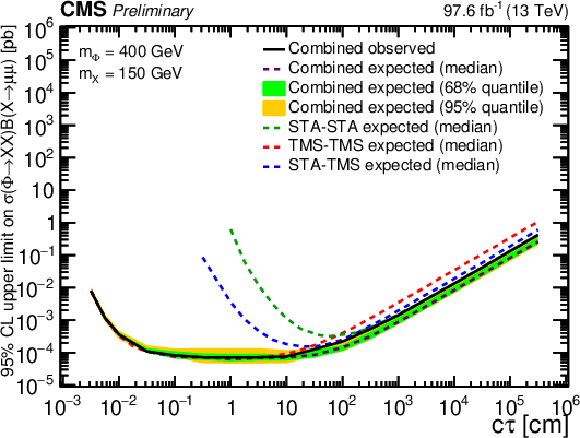
png pdf root |
Figure 16-c:
The 95% CL upper limits on σ(Φ→XX)B(X→μμ) as a function of cτ(X) in the heavy scalar model, for m(Φ)= 400 GeV and (upper left) m(X)= 20 GeV, (upper right) m(X)= 50 GeV, and (lower) m(X)= 150 GeV. The median expected limits obtained from the STA-STA, STA-TMS, and TMS-TMS dimuon categories are shown as dashed green, blue, and red curves, respectively; the combined median expected limits are shown as dashed black curves; the combined observed limits are shown as solid black curves. The green and the yellow bands correspond, respectively, to the 68% and 95% quantiles for the combined expected limits. |
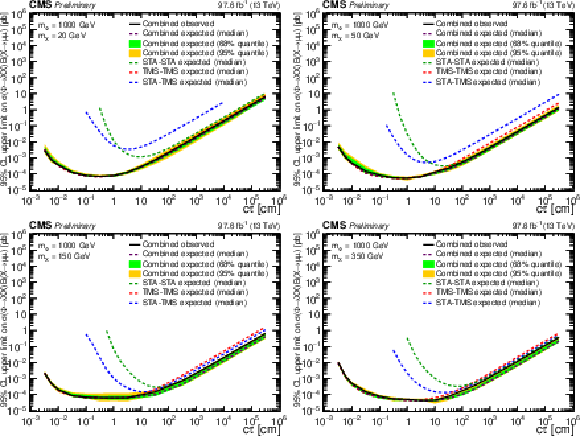
png pdf |
Figure 17:
The 95% CL upper limits on σ(Φ→XX)B(X→μμ) as a function of cτ(X) in the heavy scalar model, for m(Φ)= 1 TeV and (upper left) m(X)= 20 GeV, (upper right) m(X)= 50 GeV, (lower left) m(X)= 150 GeV, and (lower right) m(X)= 350 GeV. The median expected limits obtained from the STA-STA, STA-TMS, and TMS-TMS dimuon categories are shown as dashed green, blue, and red curves, respectively; the combined median expected limits are shown as dashed black curves; the combined observed limits are shown as solid black curves. The green and the yellow bands correspond, respectively, to the 68% and 95% quantiles for the combined expected limits. |

png pdf root |
Figure 17-a:
The 95% CL upper limits on σ(Φ→XX)B(X→μμ) as a function of cτ(X) in the heavy scalar model, for m(Φ)= 1 TeV and (upper left) m(X)= 20 GeV, (upper right) m(X)= 50 GeV, (lower left) m(X)= 150 GeV, and (lower right) m(X)= 350 GeV. The median expected limits obtained from the STA-STA, STA-TMS, and TMS-TMS dimuon categories are shown as dashed green, blue, and red curves, respectively; the combined median expected limits are shown as dashed black curves; the combined observed limits are shown as solid black curves. The green and the yellow bands correspond, respectively, to the 68% and 95% quantiles for the combined expected limits. |
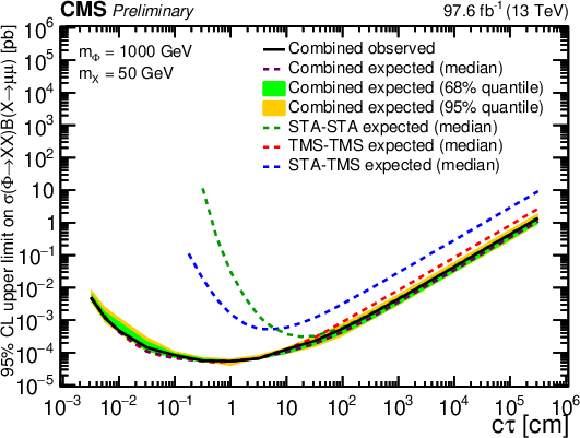
png pdf root |
Figure 17-b:
The 95% CL upper limits on σ(Φ→XX)B(X→μμ) as a function of cτ(X) in the heavy scalar model, for m(Φ)= 1 TeV and (upper left) m(X)= 20 GeV, (upper right) m(X)= 50 GeV, (lower left) m(X)= 150 GeV, and (lower right) m(X)= 350 GeV. The median expected limits obtained from the STA-STA, STA-TMS, and TMS-TMS dimuon categories are shown as dashed green, blue, and red curves, respectively; the combined median expected limits are shown as dashed black curves; the combined observed limits are shown as solid black curves. The green and the yellow bands correspond, respectively, to the 68% and 95% quantiles for the combined expected limits. |
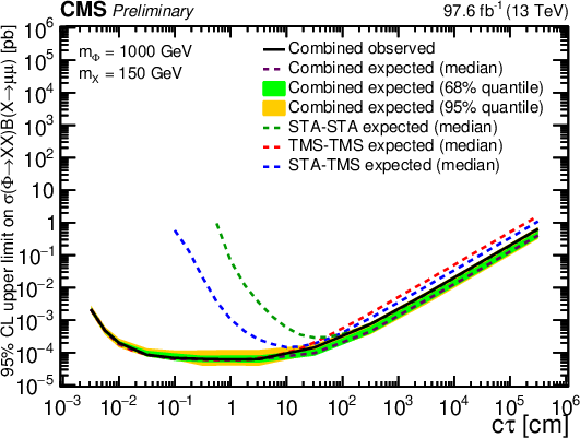
png pdf root |
Figure 17-c:
The 95% CL upper limits on σ(Φ→XX)B(X→μμ) as a function of cτ(X) in the heavy scalar model, for m(Φ)= 1 TeV and (upper left) m(X)= 20 GeV, (upper right) m(X)= 50 GeV, (lower left) m(X)= 150 GeV, and (lower right) m(X)= 350 GeV. The median expected limits obtained from the STA-STA, STA-TMS, and TMS-TMS dimuon categories are shown as dashed green, blue, and red curves, respectively; the combined median expected limits are shown as dashed black curves; the combined observed limits are shown as solid black curves. The green and the yellow bands correspond, respectively, to the 68% and 95% quantiles for the combined expected limits. |

png pdf root |
Figure 17-d:
The 95% CL upper limits on σ(Φ→XX)B(X→μμ) as a function of cτ(X) in the heavy scalar model, for m(Φ)= 1 TeV and (upper left) m(X)= 20 GeV, (upper right) m(X)= 50 GeV, (lower left) m(X)= 150 GeV, and (lower right) m(X)= 350 GeV. The median expected limits obtained from the STA-STA, STA-TMS, and TMS-TMS dimuon categories are shown as dashed green, blue, and red curves, respectively; the combined median expected limits are shown as dashed black curves; the combined observed limits are shown as solid black curves. The green and the yellow bands correspond, respectively, to the 68% and 95% quantiles for the combined expected limits. |
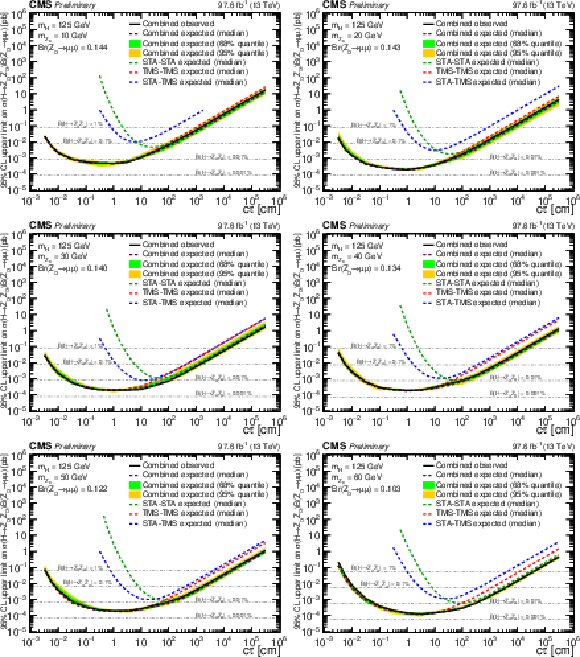
png pdf |
Figure 18:
The 95% CL upper limits on σ(H→ZDZD)B(ZD→μμ) as a function of cτ(ZD) in the HAHM model, for m(ZD) ranging from 10 GeV (upper left) to 60 GeV (lower right). The median expected limits obtained from the STA-STA, STA-TMS, and TMS-TMS dimuon categories are shown as dashed green, blue, and red curves, respectively; the combined median expected limits are shown as dashed black curves; the combined observed limits are shown as solid black curves. The green and the yellow bands correspond, respectively, to the 68% and 95% central quantiles for the combined expected limits. The horizontal lines in gray correspond to the theoretical predictions for values of B(H→ZDZD) indicated next to the lines. |
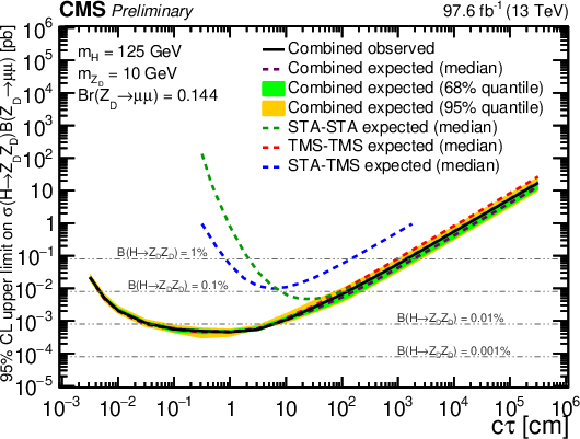
png pdf root |
Figure 18-a:
The 95% CL upper limits on σ(H→ZDZD)B(ZD→μμ) as a function of cτ(ZD) in the HAHM model, for m(ZD) ranging from 10 GeV (upper left) to 60 GeV (lower right). The median expected limits obtained from the STA-STA, STA-TMS, and TMS-TMS dimuon categories are shown as dashed green, blue, and red curves, respectively; the combined median expected limits are shown as dashed black curves; the combined observed limits are shown as solid black curves. The green and the yellow bands correspond, respectively, to the 68% and 95% central quantiles for the combined expected limits. The horizontal lines in gray correspond to the theoretical predictions for values of B(H→ZDZD) indicated next to the lines. |
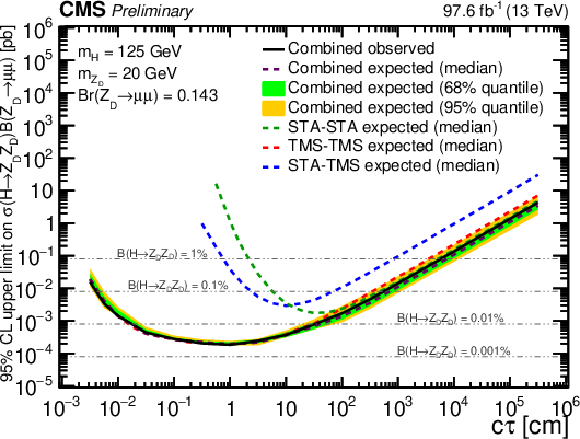
png pdf root |
Figure 18-b:
The 95% CL upper limits on σ(H→ZDZD)B(ZD→μμ) as a function of cτ(ZD) in the HAHM model, for m(ZD) ranging from 10 GeV (upper left) to 60 GeV (lower right). The median expected limits obtained from the STA-STA, STA-TMS, and TMS-TMS dimuon categories are shown as dashed green, blue, and red curves, respectively; the combined median expected limits are shown as dashed black curves; the combined observed limits are shown as solid black curves. The green and the yellow bands correspond, respectively, to the 68% and 95% central quantiles for the combined expected limits. The horizontal lines in gray correspond to the theoretical predictions for values of B(H→ZDZD) indicated next to the lines. |

png pdf root |
Figure 18-c:
The 95% CL upper limits on σ(H→ZDZD)B(ZD→μμ) as a function of cτ(ZD) in the HAHM model, for m(ZD) ranging from 10 GeV (upper left) to 60 GeV (lower right). The median expected limits obtained from the STA-STA, STA-TMS, and TMS-TMS dimuon categories are shown as dashed green, blue, and red curves, respectively; the combined median expected limits are shown as dashed black curves; the combined observed limits are shown as solid black curves. The green and the yellow bands correspond, respectively, to the 68% and 95% central quantiles for the combined expected limits. The horizontal lines in gray correspond to the theoretical predictions for values of B(H→ZDZD) indicated next to the lines. |
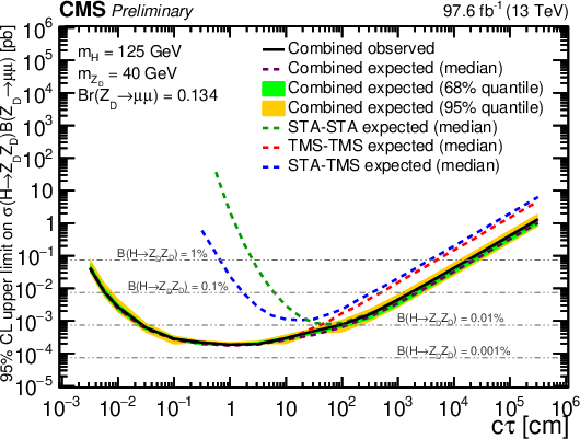
png pdf root |
Figure 18-d:
The 95% CL upper limits on σ(H→ZDZD)B(ZD→μμ) as a function of cτ(ZD) in the HAHM model, for m(ZD) ranging from 10 GeV (upper left) to 60 GeV (lower right). The median expected limits obtained from the STA-STA, STA-TMS, and TMS-TMS dimuon categories are shown as dashed green, blue, and red curves, respectively; the combined median expected limits are shown as dashed black curves; the combined observed limits are shown as solid black curves. The green and the yellow bands correspond, respectively, to the 68% and 95% central quantiles for the combined expected limits. The horizontal lines in gray correspond to the theoretical predictions for values of B(H→ZDZD) indicated next to the lines. |
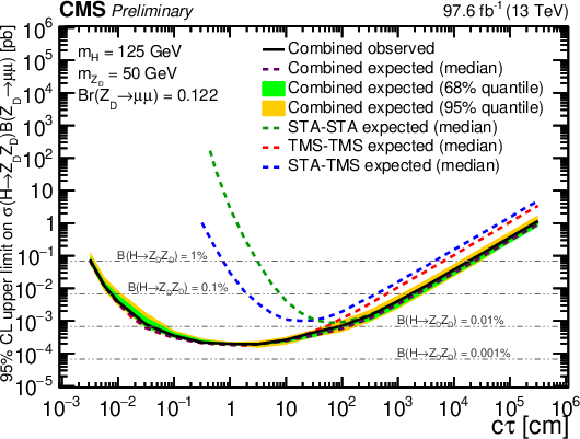
png pdf root |
Figure 18-e:
The 95% CL upper limits on σ(H→ZDZD)B(ZD→μμ) as a function of cτ(ZD) in the HAHM model, for m(ZD) ranging from 10 GeV (upper left) to 60 GeV (lower right). The median expected limits obtained from the STA-STA, STA-TMS, and TMS-TMS dimuon categories are shown as dashed green, blue, and red curves, respectively; the combined median expected limits are shown as dashed black curves; the combined observed limits are shown as solid black curves. The green and the yellow bands correspond, respectively, to the 68% and 95% central quantiles for the combined expected limits. The horizontal lines in gray correspond to the theoretical predictions for values of B(H→ZDZD) indicated next to the lines. |
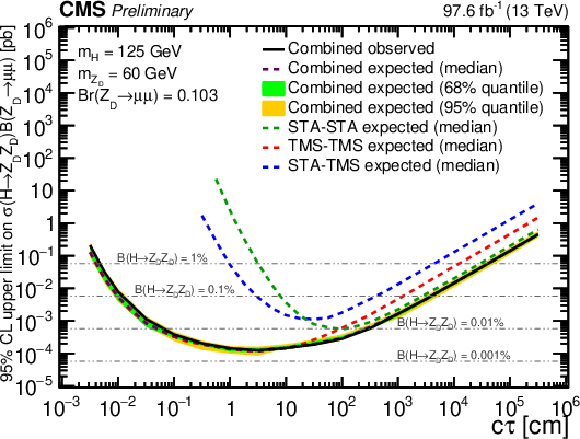
png pdf root |
Figure 18-f:
The 95% CL upper limits on σ(H→ZDZD)B(ZD→μμ) as a function of cτ(ZD) in the HAHM model, for m(ZD) ranging from 10 GeV (upper left) to 60 GeV (lower right). The median expected limits obtained from the STA-STA, STA-TMS, and TMS-TMS dimuon categories are shown as dashed green, blue, and red curves, respectively; the combined median expected limits are shown as dashed black curves; the combined observed limits are shown as solid black curves. The green and the yellow bands correspond, respectively, to the 68% and 95% central quantiles for the combined expected limits. The horizontal lines in gray correspond to the theoretical predictions for values of B(H→ZDZD) indicated next to the lines. |
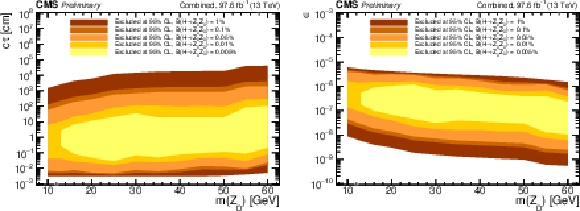
png pdf |
Figure 19:
Observed 95% CL exclusion contours in the HAHM model, in the (left) (m(ZD), cτ(ZD)) and (right) (m(ZD), ϵ) planes. The contours correspond to several representative values of B(H→ZDZD) ranging from 0.005% to 1%. |
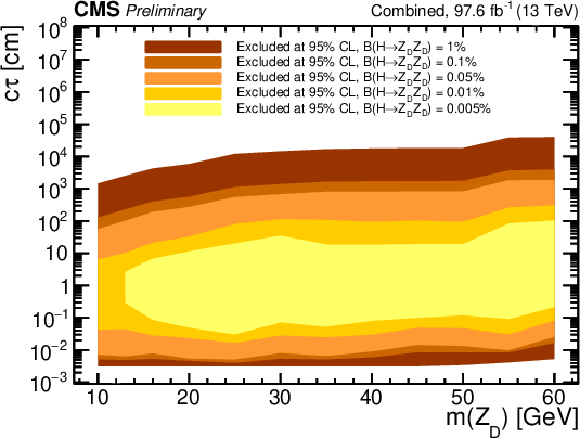
png pdf root |
Figure 19-a:
Observed 95% CL exclusion contours in the HAHM model, in the (left) (m(ZD), cτ(ZD)) and (right) (m(ZD), ϵ) planes. The contours correspond to several representative values of B(H→ZDZD) ranging from 0.005% to 1%. |

png pdf root |
Figure 19-b:
Observed 95% CL exclusion contours in the HAHM model, in the (left) (m(ZD), cτ(ZD)) and (right) (m(ZD), ϵ) planes. The contours correspond to several representative values of B(H→ZDZD) ranging from 0.005% to 1%. |
| Summary |
| A data set collected by the CMS experiment in proton-proton collisions at √s= 13 TeV in 2016 and 2018 and corresponding to an integrated luminosity of 97.6 fb−1 has been used to conduct an inclusive search for long-lived exotic neutral particles (LLPs) decaying to a pair of muons. The search is largely model-independent and is sensitive to a broad range of LLP lifetimes and masses. No excess of events above the standard model prediction is observed. The results are interpreted as upper limits on the parameters of the Hidden Abelian Higgs model, in which the Higgs boson decays to a pair of long-lived dark photons ZD, and of a simplified model, in which LLPs are produced in decays of an exotic heavy neutral scalar boson. The branching fraction of the Higgs boson to dark photons of 1% is excluded at 95% confidence level in the ZD range between 20 and 60 GeV and for cτ (ZD) from a few tens of μm to approximately 100 m. The results of this search significantly extend the excluded range of model parameters. They provide the best limits to date for the Hidden Abelian Higgs model with ZD masses larger than 20 GeV and all cτ (ZD) values except those between about 0.5 and 200 mm, where our search is complemented by the CMS search using data collected with high-rate triggers [35]. At exotic scalar boson masses larger than the Higgs boson mass, our results represent the best current constraints for all considered LLP masses and lifetimes. |
| Additional Figures | |
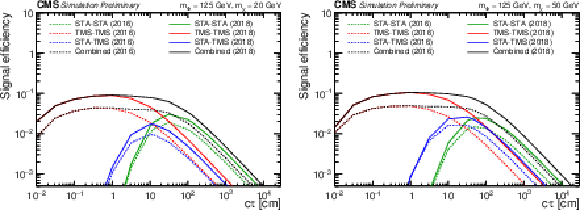
png pdf |
Additional Figure 1:
Overall signal efficiencies as a function of cτ for the Φ→2X→2μ signal process with mΦ= 125 GeV (left: mX= 20 GeV, right: mX= 50 GeV). Each figure shows efficiencies in the three dimuon categories, STA-STA (green), TMS-TMS (red), and STA-TMS (blue), as well as the combined efficiency (black) calculated as the sum of the efficiencies of the individual categories. The signal efficiencies for the 2016 and 2018 datasets are shown as dashed and solid lines, respectively. |

png pdf root |
Additional Figure 1-a:
Overall signal efficiencies as a function of cτ for the Φ→2X→2μ signal process with mΦ= 125 GeV (left: mX= 20 GeV, right: mX= 50 GeV). Each figure shows efficiencies in the three dimuon categories, STA-STA (green), TMS-TMS (red), and STA-TMS (blue), as well as the combined efficiency (black) calculated as the sum of the efficiencies of the individual categories. The signal efficiencies for the 2016 and 2018 datasets are shown as dashed and solid lines, respectively. |

png pdf root |
Additional Figure 1-b:
Overall signal efficiencies as a function of cτ for the Φ→2X→2μ signal process with mΦ= 125 GeV (left: mX= 20 GeV, right: mX= 50 GeV). Each figure shows efficiencies in the three dimuon categories, STA-STA (green), TMS-TMS (red), and STA-TMS (blue), as well as the combined efficiency (black) calculated as the sum of the efficiencies of the individual categories. The signal efficiencies for the 2016 and 2018 datasets are shown as dashed and solid lines, respectively. |

png pdf |
Additional Figure 2:
Overall signal efficiencies as a function of cτ for the Φ→2X→2μ signal process with mΦ= 200 GeV (left: mX= 20 GeV, right: mX= 50 GeV). Each figure shows efficiencies in the three dimuon categories, STA-STA (green), TMS-TMS (red), and STA-TMS (blue), as well as the combined efficiency (black) calculated as the sum of the efficiencies of the individual categories. The signal efficiencies for the 2016 and 2018 datasets are shown as dashed and solid lines, respectively. |

png pdf root |
Additional Figure 2-a:
Overall signal efficiencies as a function of cτ for the Φ→2X→2μ signal process with mΦ= 200 GeV (left: mX= 20 GeV, right: mX= 50 GeV). Each figure shows efficiencies in the three dimuon categories, STA-STA (green), TMS-TMS (red), and STA-TMS (blue), as well as the combined efficiency (black) calculated as the sum of the efficiencies of the individual categories. The signal efficiencies for the 2016 and 2018 datasets are shown as dashed and solid lines, respectively. |

png pdf root |
Additional Figure 2-b:
Overall signal efficiencies as a function of cτ for the Φ→2X→2μ signal process with mΦ= 200 GeV (left: mX= 20 GeV, right: mX= 50 GeV). Each figure shows efficiencies in the three dimuon categories, STA-STA (green), TMS-TMS (red), and STA-TMS (blue), as well as the combined efficiency (black) calculated as the sum of the efficiencies of the individual categories. The signal efficiencies for the 2016 and 2018 datasets are shown as dashed and solid lines, respectively. |
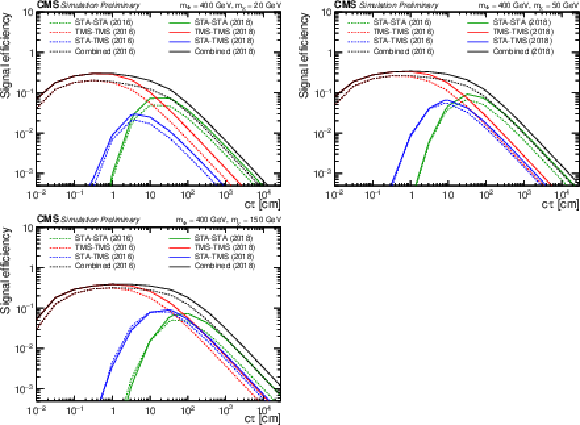
png pdf |
Additional Figure 3:
Overall signal efficiencies as a function of cτ for the Φ→2X→2μ signal process with mΦ= 400 GeV (top left: mX= 20 GeV, top right: mX= 50 GeV, bottom: mX= 150 GeV). Each figure shows efficiencies in the three dimuon categories, STA-STA (green), TMS-TMS (red), and STA-TMS (blue), as well as the combined efficiency (black) calculated as the sum of the efficiencies of the individual categories. The signal efficiencies for the 2016 and 2018 datasets are shown as dashed and solid lines, respectively. |

png pdf root |
Additional Figure 3-a:
Overall signal efficiencies as a function of cτ for the Φ→2X→2μ signal process with mΦ= 400 GeV (top left: mX= 20 GeV, top right: mX= 50 GeV, bottom: mX= 150 GeV). Each figure shows efficiencies in the three dimuon categories, STA-STA (green), TMS-TMS (red), and STA-TMS (blue), as well as the combined efficiency (black) calculated as the sum of the efficiencies of the individual categories. The signal efficiencies for the 2016 and 2018 datasets are shown as dashed and solid lines, respectively. |
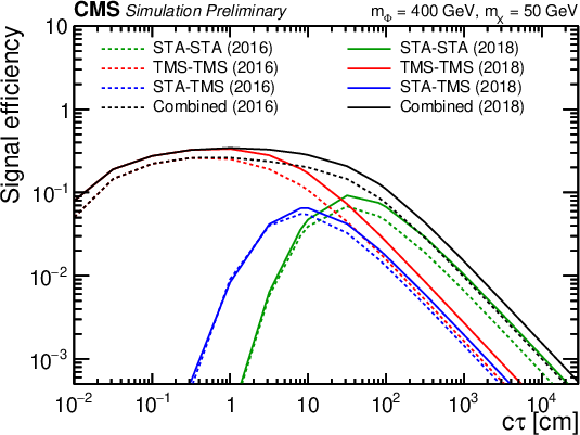
png pdf root |
Additional Figure 3-b:
Overall signal efficiencies as a function of cτ for the Φ→2X→2μ signal process with mΦ= 400 GeV (top left: mX= 20 GeV, top right: mX= 50 GeV, bottom: mX= 150 GeV). Each figure shows efficiencies in the three dimuon categories, STA-STA (green), TMS-TMS (red), and STA-TMS (blue), as well as the combined efficiency (black) calculated as the sum of the efficiencies of the individual categories. The signal efficiencies for the 2016 and 2018 datasets are shown as dashed and solid lines, respectively. |

png pdf root |
Additional Figure 3-c:
Overall signal efficiencies as a function of cτ for the Φ→2X→2μ signal process with mΦ= 400 GeV (top left: mX= 20 GeV, top right: mX= 50 GeV, bottom: mX= 150 GeV). Each figure shows efficiencies in the three dimuon categories, STA-STA (green), TMS-TMS (red), and STA-TMS (blue), as well as the combined efficiency (black) calculated as the sum of the efficiencies of the individual categories. The signal efficiencies for the 2016 and 2018 datasets are shown as dashed and solid lines, respectively. |
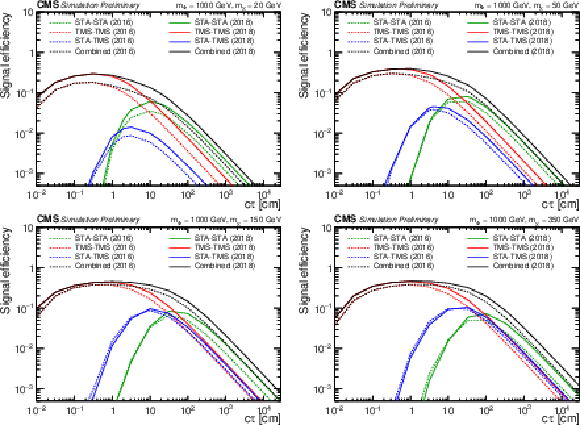
png pdf |
Additional Figure 4:
Overall signal efficiencies as a function of cτ for the Φ→2X→2μ signal process with mΦ= 1 TeV (top left: mX= 20 GeV, top right: mX= 50 GeV, bottom left: mX= 150 GeV, bottom right: mX= 350 GeV). Each figure shows efficiencies in the three dimuon categories, STA-STA (green), TMS-TMS (red), and STA-TMS (blue), as well as the combined efficiency (black) calculated as the sum of the efficiencies of the individual categories. The signal efficiencies for the 2016 and 2018 datasets are shown as dashed and solid lines, respectively. |
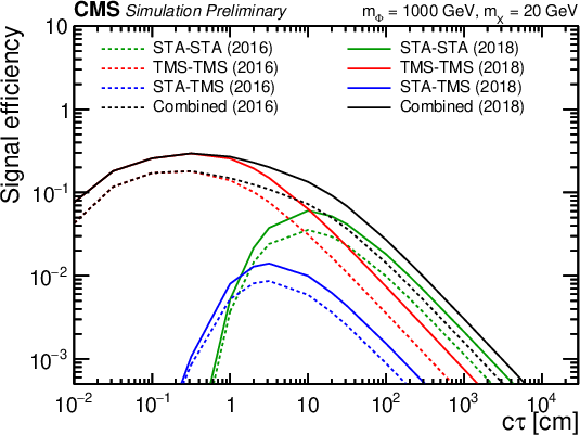
png pdf root |
Additional Figure 4-a:
Overall signal efficiencies as a function of cτ for the Φ→2X→2μ signal process with mΦ= 1 TeV (top left: mX= 20 GeV, top right: mX= 50 GeV, bottom left: mX= 150 GeV, bottom right: mX= 350 GeV). Each figure shows efficiencies in the three dimuon categories, STA-STA (green), TMS-TMS (red), and STA-TMS (blue), as well as the combined efficiency (black) calculated as the sum of the efficiencies of the individual categories. The signal efficiencies for the 2016 and 2018 datasets are shown as dashed and solid lines, respectively. |

png pdf root |
Additional Figure 4-b:
Overall signal efficiencies as a function of cτ for the Φ→2X→2μ signal process with mΦ= 1 TeV (top left: mX= 20 GeV, top right: mX= 50 GeV, bottom left: mX= 150 GeV, bottom right: mX= 350 GeV). Each figure shows efficiencies in the three dimuon categories, STA-STA (green), TMS-TMS (red), and STA-TMS (blue), as well as the combined efficiency (black) calculated as the sum of the efficiencies of the individual categories. The signal efficiencies for the 2016 and 2018 datasets are shown as dashed and solid lines, respectively. |
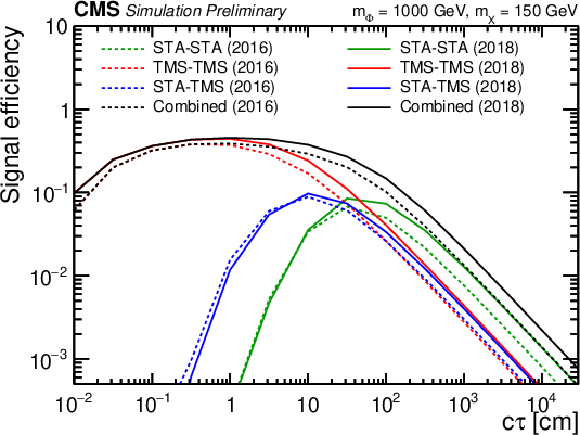
png pdf root |
Additional Figure 4-c:
Overall signal efficiencies as a function of cτ for the Φ→2X→2μ signal process with mΦ= 1 TeV (top left: mX= 20 GeV, top right: mX= 50 GeV, bottom left: mX= 150 GeV, bottom right: mX= 350 GeV). Each figure shows efficiencies in the three dimuon categories, STA-STA (green), TMS-TMS (red), and STA-TMS (blue), as well as the combined efficiency (black) calculated as the sum of the efficiencies of the individual categories. The signal efficiencies for the 2016 and 2018 datasets are shown as dashed and solid lines, respectively. |

png pdf root |
Additional Figure 4-d:
Overall signal efficiencies as a function of cτ for the Φ→2X→2μ signal process with mΦ= 1 TeV (top left: mX= 20 GeV, top right: mX= 50 GeV, bottom left: mX= 150 GeV, bottom right: mX= 350 GeV). Each figure shows efficiencies in the three dimuon categories, STA-STA (green), TMS-TMS (red), and STA-TMS (blue), as well as the combined efficiency (black) calculated as the sum of the efficiencies of the individual categories. The signal efficiencies for the 2016 and 2018 datasets are shown as dashed and solid lines, respectively. |
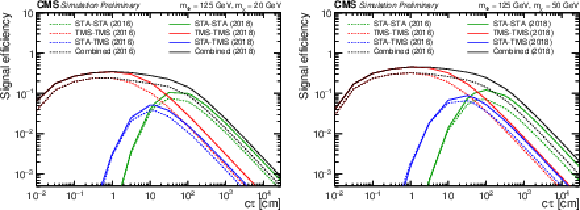
png pdf |
Additional Figure 5:
Overall signal efficiencies as a function of cτ for the Φ→2X→4μ signal process with mΦ= 125 GeV (left: mX= 20 GeV, right: mX= 50 GeV). Each figure shows efficiencies in the three dimuon categories, STA-STA (green), TMS-TMS (red), and STA-TMS (blue), as well as the combined efficiency (black) calculated as the sum of the efficiencies of the individual categories. The signal efficiencies for the 2016 and 2018 datasets are shown as dashed and solid lines, respectively. |

png pdf root |
Additional Figure 5-a:
Overall signal efficiencies as a function of cτ for the Φ→2X→4μ signal process with mΦ= 125 GeV (left: mX= 20 GeV, right: mX= 50 GeV). Each figure shows efficiencies in the three dimuon categories, STA-STA (green), TMS-TMS (red), and STA-TMS (blue), as well as the combined efficiency (black) calculated as the sum of the efficiencies of the individual categories. The signal efficiencies for the 2016 and 2018 datasets are shown as dashed and solid lines, respectively. |

png pdf root |
Additional Figure 5-b:
Overall signal efficiencies as a function of cτ for the Φ→2X→4μ signal process with mΦ= 125 GeV (left: mX= 20 GeV, right: mX= 50 GeV). Each figure shows efficiencies in the three dimuon categories, STA-STA (green), TMS-TMS (red), and STA-TMS (blue), as well as the combined efficiency (black) calculated as the sum of the efficiencies of the individual categories. The signal efficiencies for the 2016 and 2018 datasets are shown as dashed and solid lines, respectively. |
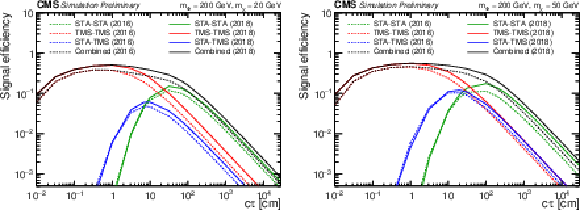
png pdf |
Additional Figure 6:
Overall signal efficiencies as a function of cτ for the Φ→2X→4μ signal process with mΦ= 200 GeV (left: mX= 20 GeV, right: mX= 50 GeV). Each figure shows efficiencies in the three dimuon categories, STA-STA (green), TMS-TMS (red), and STA-TMS (blue), as well as the combined efficiency (black) calculated as the sum of the efficiencies of the individual categories. The signal efficiencies for the 2016 and 2018 datasets are shown as dashed and solid lines, respectively. |
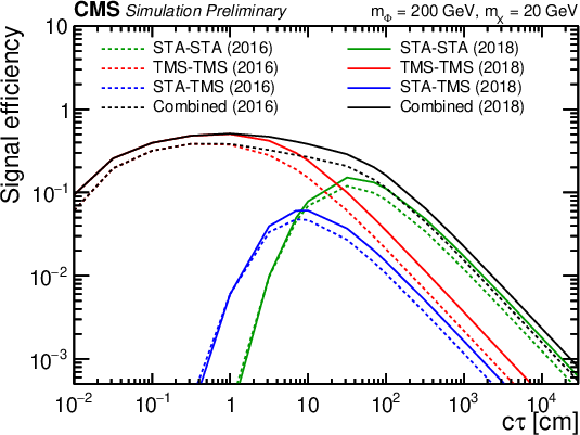
png pdf root |
Additional Figure 6-a:
Overall signal efficiencies as a function of cτ for the Φ→2X→4μ signal process with mΦ= 200 GeV (left: mX= 20 GeV, right: mX= 50 GeV). Each figure shows efficiencies in the three dimuon categories, STA-STA (green), TMS-TMS (red), and STA-TMS (blue), as well as the combined efficiency (black) calculated as the sum of the efficiencies of the individual categories. The signal efficiencies for the 2016 and 2018 datasets are shown as dashed and solid lines, respectively. |
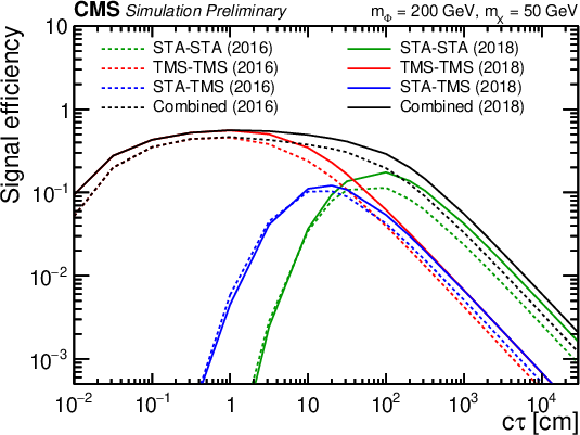
png pdf root |
Additional Figure 6-b:
Overall signal efficiencies as a function of cτ for the Φ→2X→4μ signal process with mΦ= 200 GeV (left: mX= 20 GeV, right: mX= 50 GeV). Each figure shows efficiencies in the three dimuon categories, STA-STA (green), TMS-TMS (red), and STA-TMS (blue), as well as the combined efficiency (black) calculated as the sum of the efficiencies of the individual categories. The signal efficiencies for the 2016 and 2018 datasets are shown as dashed and solid lines, respectively. |
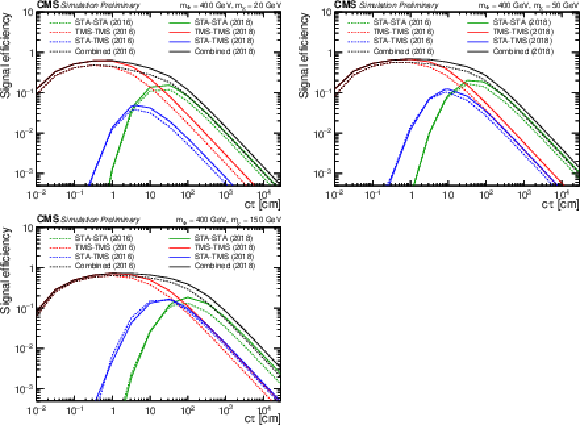
png pdf |
Additional Figure 7:
Overall signal efficiencies as a function of cτ for the Φ→2X→4μ signal process with mΦ= 400 GeV (top left: mX= 20 GeV, top right: mX= 50 GeV, bottom: mX= 150 GeV). Each figure shows efficiencies in the three dimuon categories, STA-STA (green), TMS-TMS (red), and STA-TMS (blue), as well as the combined efficiency (black) calculated as the sum of the efficiencies of the individual categories. The signal efficiencies for the 2016 and 2018 datasets are shown as dashed and solid lines, respectively. |
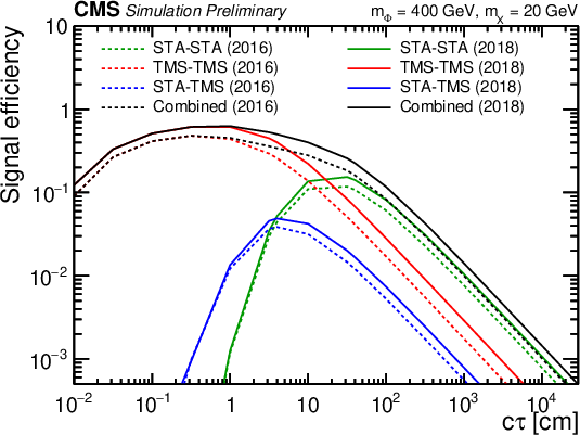
png pdf root |
Additional Figure 7-a:
Overall signal efficiencies as a function of cτ for the Φ→2X→4μ signal process with mΦ= 400 GeV (top left: mX= 20 GeV, top right: mX= 50 GeV, bottom: mX= 150 GeV). Each figure shows efficiencies in the three dimuon categories, STA-STA (green), TMS-TMS (red), and STA-TMS (blue), as well as the combined efficiency (black) calculated as the sum of the efficiencies of the individual categories. The signal efficiencies for the 2016 and 2018 datasets are shown as dashed and solid lines, respectively. |
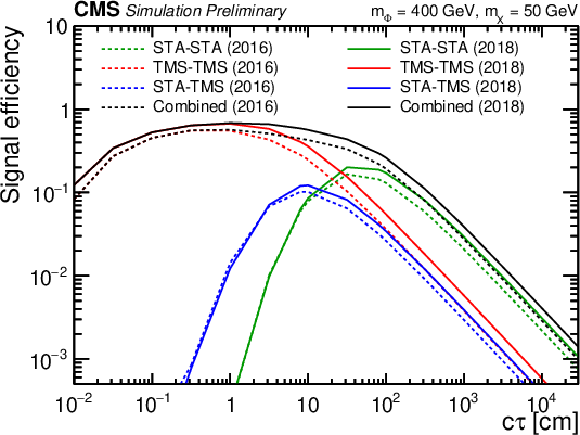
png pdf root |
Additional Figure 7-b:
Overall signal efficiencies as a function of cτ for the Φ→2X→4μ signal process with mΦ= 400 GeV (top left: mX= 20 GeV, top right: mX= 50 GeV, bottom: mX= 150 GeV). Each figure shows efficiencies in the three dimuon categories, STA-STA (green), TMS-TMS (red), and STA-TMS (blue), as well as the combined efficiency (black) calculated as the sum of the efficiencies of the individual categories. The signal efficiencies for the 2016 and 2018 datasets are shown as dashed and solid lines, respectively. |
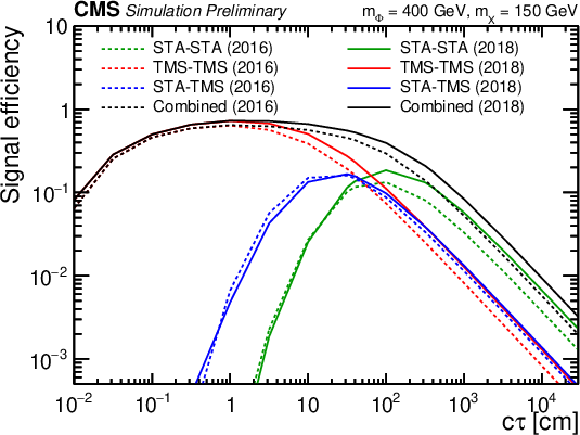
png pdf root |
Additional Figure 7-c:
Overall signal efficiencies as a function of cτ for the Φ→2X→4μ signal process with mΦ= 400 GeV (top left: mX= 20 GeV, top right: mX= 50 GeV, bottom: mX= 150 GeV). Each figure shows efficiencies in the three dimuon categories, STA-STA (green), TMS-TMS (red), and STA-TMS (blue), as well as the combined efficiency (black) calculated as the sum of the efficiencies of the individual categories. The signal efficiencies for the 2016 and 2018 datasets are shown as dashed and solid lines, respectively. |

png pdf |
Additional Figure 8:
Overall signal efficiencies as a function of cτ for the Φ→2X→4μ signal process with mΦ= 1 TeV (top left: mX= 20 GeV, top right: mX= 50 GeV, bottom left: mX= 150 GeV, bottom right: mX= 350 GeV). Each figure shows efficiencies in the three dimuon categories, STA-STA (green), TMS-TMS (red), and STA-TMS (blue), as well as the combined efficiency (black) calculated as the sum of the efficiencies of the individual categories. The signal efficiencies for the 2016 and 2018 datasets are shown as dashed and solid lines, respectively. |

png pdf root |
Additional Figure 8-a:
Overall signal efficiencies as a function of cτ for the Φ→2X→4μ signal process with mΦ= 1 TeV (top left: mX= 20 GeV, top right: mX= 50 GeV, bottom left: mX= 150 GeV, bottom right: mX= 350 GeV). Each figure shows efficiencies in the three dimuon categories, STA-STA (green), TMS-TMS (red), and STA-TMS (blue), as well as the combined efficiency (black) calculated as the sum of the efficiencies of the individual categories. The signal efficiencies for the 2016 and 2018 datasets are shown as dashed and solid lines, respectively. |
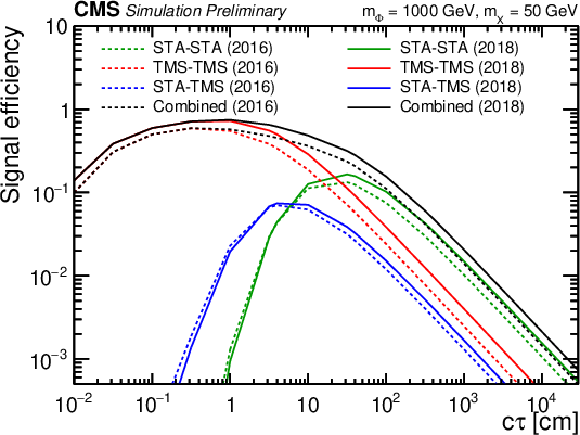
png pdf root |
Additional Figure 8-b:
Overall signal efficiencies as a function of cτ for the Φ→2X→4μ signal process with mΦ= 1 TeV (top left: mX= 20 GeV, top right: mX= 50 GeV, bottom left: mX= 150 GeV, bottom right: mX= 350 GeV). Each figure shows efficiencies in the three dimuon categories, STA-STA (green), TMS-TMS (red), and STA-TMS (blue), as well as the combined efficiency (black) calculated as the sum of the efficiencies of the individual categories. The signal efficiencies for the 2016 and 2018 datasets are shown as dashed and solid lines, respectively. |
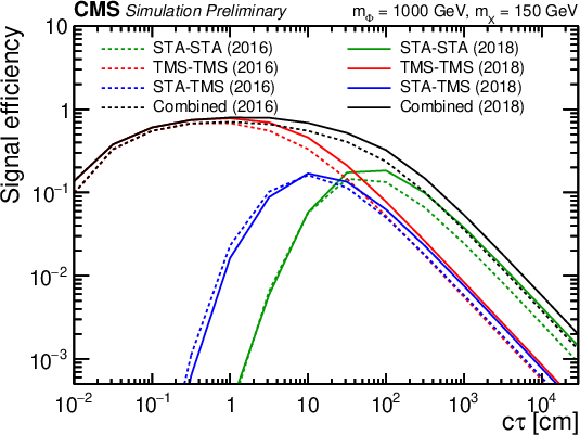
png pdf root |
Additional Figure 8-c:
Overall signal efficiencies as a function of cτ for the Φ→2X→4μ signal process with mΦ= 1 TeV (top left: mX= 20 GeV, top right: mX= 50 GeV, bottom left: mX= 150 GeV, bottom right: mX= 350 GeV). Each figure shows efficiencies in the three dimuon categories, STA-STA (green), TMS-TMS (red), and STA-TMS (blue), as well as the combined efficiency (black) calculated as the sum of the efficiencies of the individual categories. The signal efficiencies for the 2016 and 2018 datasets are shown as dashed and solid lines, respectively. |

png pdf root |
Additional Figure 8-d:
Overall signal efficiencies as a function of cτ for the Φ→2X→4μ signal process with mΦ= 1 TeV (top left: mX= 20 GeV, top right: mX= 50 GeV, bottom left: mX= 150 GeV, bottom right: mX= 350 GeV). Each figure shows efficiencies in the three dimuon categories, STA-STA (green), TMS-TMS (red), and STA-TMS (blue), as well as the combined efficiency (black) calculated as the sum of the efficiencies of the individual categories. The signal efficiencies for the 2016 and 2018 datasets are shown as dashed and solid lines, respectively. |

png pdf |
Additional Figure 9:
Overall signal efficiencies as a function of cτ for the H→2ZD→2μ2X signal process with m(H)= 125 GeV (top left to bottom right: mZD= 10, 20, 30, 40, 50, 60 GeV). Each figure shows efficiencies in the three dimuon categories, STA-STA (green), TMS-TMS (red), and STA-TMS (blue), as well the combined efficiency (black) calculated as the sum of the efficiencies of the individual categories. The signal efficiencies for the 2016 and 2018 datasets are shown as dashed and solid lines, respectively. |
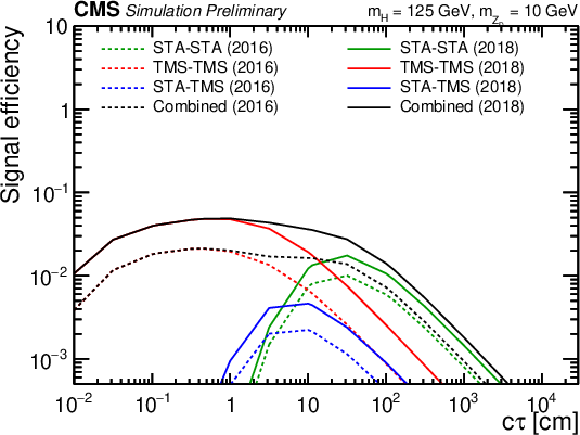
png pdf root |
Additional Figure 9-a:
Overall signal efficiencies as a function of cτ for the H→2ZD→2μ2X signal process with m(H)= 125 GeV (top left to bottom right: mZD= 10, 20, 30, 40, 50, 60 GeV). Each figure shows efficiencies in the three dimuon categories, STA-STA (green), TMS-TMS (red), and STA-TMS (blue), as well the combined efficiency (black) calculated as the sum of the efficiencies of the individual categories. The signal efficiencies for the 2016 and 2018 datasets are shown as dashed and solid lines, respectively. |
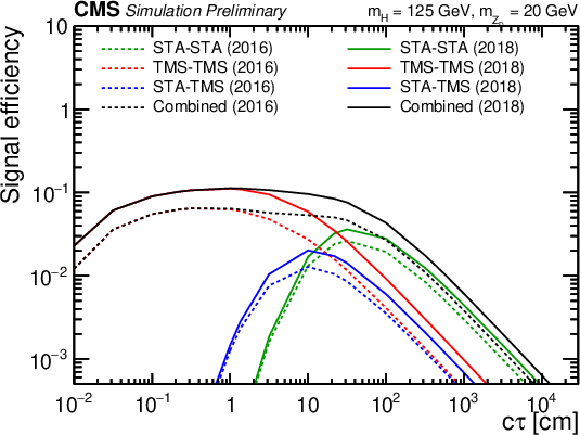
png pdf root |
Additional Figure 9-b:
Overall signal efficiencies as a function of cτ for the H→2ZD→2μ2X signal process with m(H)= 125 GeV (top left to bottom right: mZD= 10, 20, 30, 40, 50, 60 GeV). Each figure shows efficiencies in the three dimuon categories, STA-STA (green), TMS-TMS (red), and STA-TMS (blue), as well the combined efficiency (black) calculated as the sum of the efficiencies of the individual categories. The signal efficiencies for the 2016 and 2018 datasets are shown as dashed and solid lines, respectively. |

png pdf root |
Additional Figure 9-c:
Overall signal efficiencies as a function of cτ for the H→2ZD→2μ2X signal process with m(H)= 125 GeV (top left to bottom right: mZD= 10, 20, 30, 40, 50, 60 GeV). Each figure shows efficiencies in the three dimuon categories, STA-STA (green), TMS-TMS (red), and STA-TMS (blue), as well the combined efficiency (black) calculated as the sum of the efficiencies of the individual categories. The signal efficiencies for the 2016 and 2018 datasets are shown as dashed and solid lines, respectively. |
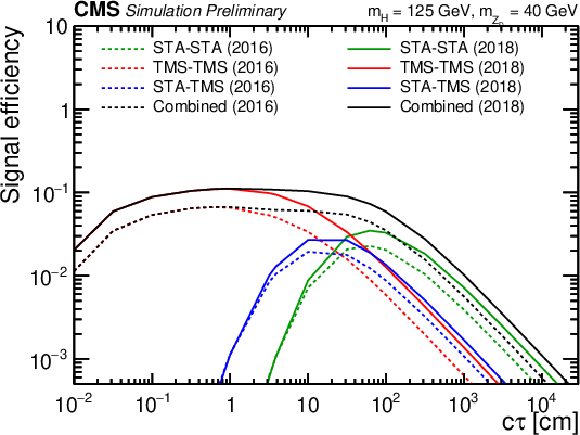
png pdf root |
Additional Figure 9-d:
Overall signal efficiencies as a function of cτ for the H→2ZD→2μ2X signal process with m(H)= 125 GeV (top left to bottom right: mZD= 10, 20, 30, 40, 50, 60 GeV). Each figure shows efficiencies in the three dimuon categories, STA-STA (green), TMS-TMS (red), and STA-TMS (blue), as well the combined efficiency (black) calculated as the sum of the efficiencies of the individual categories. The signal efficiencies for the 2016 and 2018 datasets are shown as dashed and solid lines, respectively. |
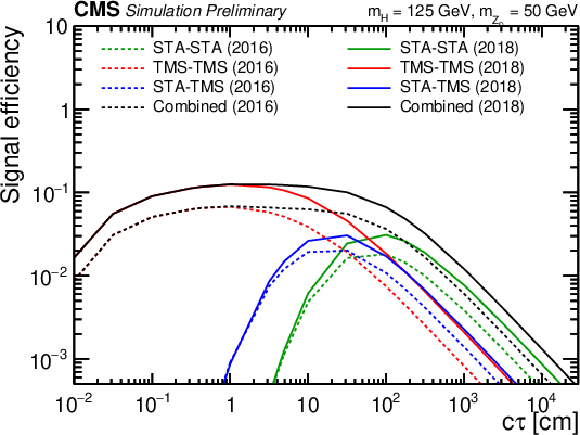
png pdf root |
Additional Figure 9-e:
Overall signal efficiencies as a function of cτ for the H→2ZD→2μ2X signal process with m(H)= 125 GeV (top left to bottom right: mZD= 10, 20, 30, 40, 50, 60 GeV). Each figure shows efficiencies in the three dimuon categories, STA-STA (green), TMS-TMS (red), and STA-TMS (blue), as well the combined efficiency (black) calculated as the sum of the efficiencies of the individual categories. The signal efficiencies for the 2016 and 2018 datasets are shown as dashed and solid lines, respectively. |
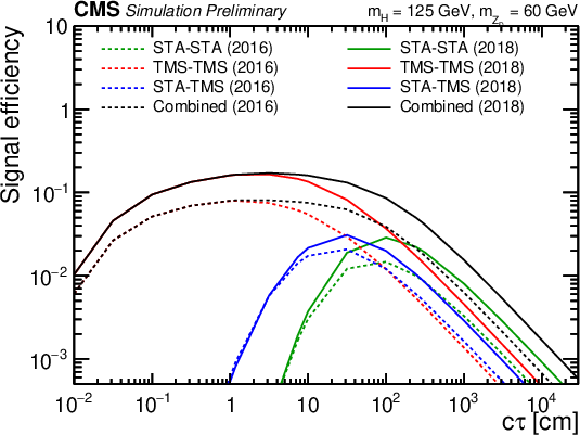
png pdf root |
Additional Figure 9-f:
Overall signal efficiencies as a function of cτ for the H→2ZD→2μ2X signal process with m(H)= 125 GeV (top left to bottom right: mZD= 10, 20, 30, 40, 50, 60 GeV). Each figure shows efficiencies in the three dimuon categories, STA-STA (green), TMS-TMS (red), and STA-TMS (blue), as well the combined efficiency (black) calculated as the sum of the efficiencies of the individual categories. The signal efficiencies for the 2016 and 2018 datasets are shown as dashed and solid lines, respectively. |
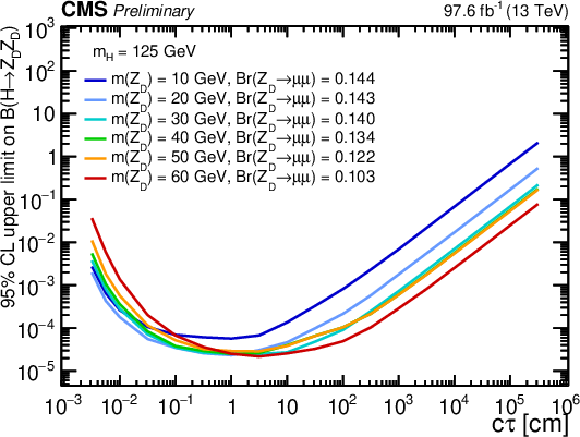
png pdf root |
Additional Figure 10:
The 95% CL combined observed upper limits on B(H→ZDZD) as a function of cτZD in the HAHM model, for mZD ranging from 10 GeV to 60 GeV. |

png pdf |
Additional Figure 11:
The 95% CL upper limits on σ(Φ→XX)B(X→μμ) as a function of cτX in the heavy scalar model, for mΦ= 125 GeV and mX= 50 GeV (top left), mΦ= 1000 GeV and mX= 150 GeV (top right), and mΦ= 1000 GeV and mX= 350 GeV (bottom). To facilitate a comparison to existing upper limits for the probed signal hypotheses, the combined observed limits (black) are compared to recent CMS results (orange). |

png pdf |
Additional Figure 11-a:
The 95% CL upper limits on σ(Φ→XX)B(X→μμ) as a function of cτX in the heavy scalar model, for mΦ= 125 GeV and mX= 50 GeV (top left), mΦ= 1000 GeV and mX= 150 GeV (top right), and mΦ= 1000 GeV and mX= 350 GeV (bottom). To facilitate a comparison to existing upper limits for the probed signal hypotheses, the combined observed limits (black) are compared to recent CMS results (orange). |
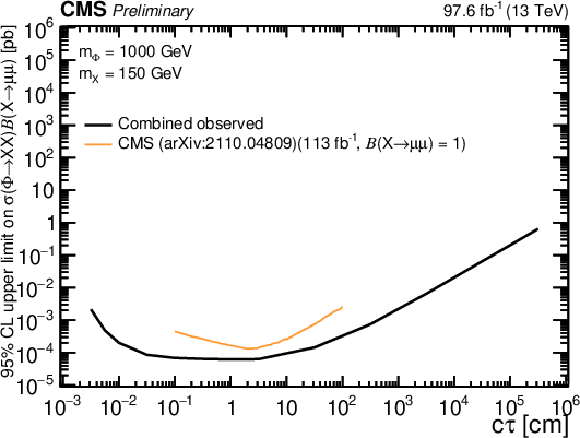
png pdf |
Additional Figure 11-b:
The 95% CL upper limits on σ(Φ→XX)B(X→μμ) as a function of cτX in the heavy scalar model, for mΦ= 125 GeV and mX= 50 GeV (top left), mΦ= 1000 GeV and mX= 150 GeV (top right), and mΦ= 1000 GeV and mX= 350 GeV (bottom). To facilitate a comparison to existing upper limits for the probed signal hypotheses, the combined observed limits (black) are compared to recent CMS results (orange). |
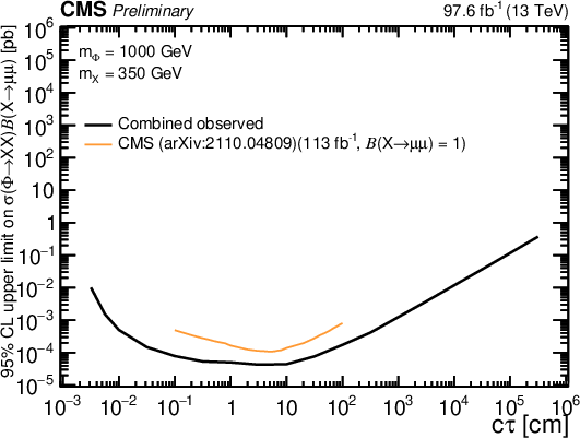
png pdf |
Additional Figure 11-c:
The 95% CL upper limits on σ(Φ→XX)B(X→μμ) as a function of cτX in the heavy scalar model, for mΦ= 125 GeV and mX= 50 GeV (top left), mΦ= 1000 GeV and mX= 150 GeV (top right), and mΦ= 1000 GeV and mX= 350 GeV (bottom). To facilitate a comparison to existing upper limits for the probed signal hypotheses, the combined observed limits (black) are compared to recent CMS results (orange). |

png pdf |
Additional Figure 12:
The 95% CL upper limits on σ(H→ZDZD)B(ZD→μμ) as a function of cτZD in the heavy scalar model, for mH= 125 GeV and mZD= 20 GeV (top left), mZD= 40 GeV (top right), and mZD= 60 GeV (bottom). To facilitate a comparison to existing upper limits for the probed signal hypotheses, the combined observed limits (black) are compared to recent CMS (red) and ATLAS (blue) results. |
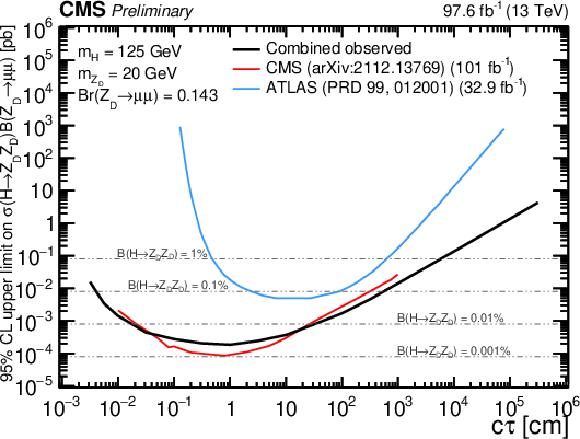
png pdf |
Additional Figure 12-a:
The 95% CL upper limits on σ(H→ZDZD)B(ZD→μμ) as a function of cτZD in the heavy scalar model, for mH= 125 GeV and mZD= 20 GeV (top left), mZD= 40 GeV (top right), and mZD= 60 GeV (bottom). To facilitate a comparison to existing upper limits for the probed signal hypotheses, the combined observed limits (black) are compared to recent CMS (red) and ATLAS (blue) results. |
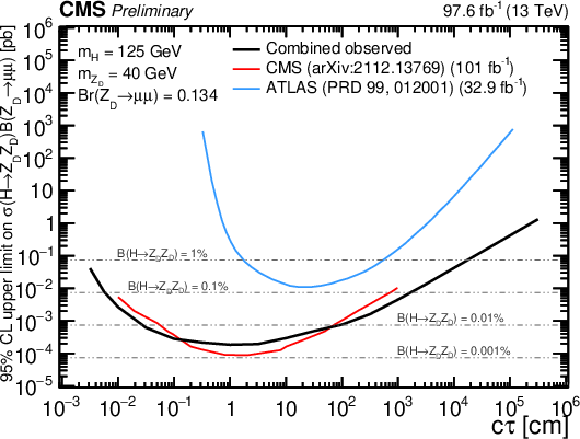
png pdf |
Additional Figure 12-b:
The 95% CL upper limits on σ(H→ZDZD)B(ZD→μμ) as a function of cτZD in the heavy scalar model, for mH= 125 GeV and mZD= 20 GeV (top left), mZD= 40 GeV (top right), and mZD= 60 GeV (bottom). To facilitate a comparison to existing upper limits for the probed signal hypotheses, the combined observed limits (black) are compared to recent CMS (red) and ATLAS (blue) results. |
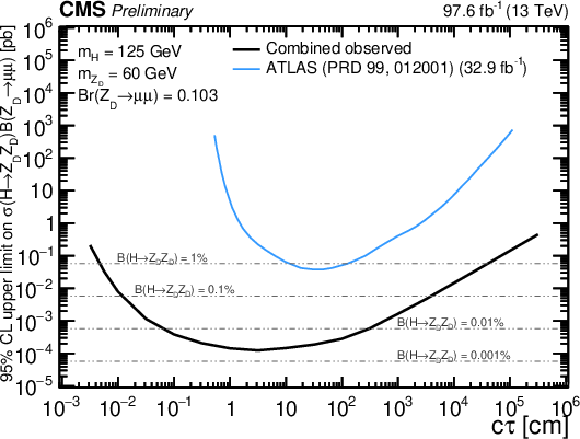
png pdf |
Additional Figure 12-c:
The 95% CL upper limits on σ(H→ZDZD)B(ZD→μμ) as a function of cτZD in the heavy scalar model, for mH= 125 GeV and mZD= 20 GeV (top left), mZD= 40 GeV (top right), and mZD= 60 GeV (bottom). To facilitate a comparison to existing upper limits for the probed signal hypotheses, the combined observed limits (black) are compared to recent CMS (red) and ATLAS (blue) results. |
| Additional Tables | |

png pdf |
Additional Table 1:
Background estimation and observed number of events in the STA-STA dimuon category in 2016 and 2018 data. For each probed LLP mass, the chosen mass interval is shown. The mass interval is followed by the estimated and observed counts for the given year. The quoted uncertainties are statistical only. |
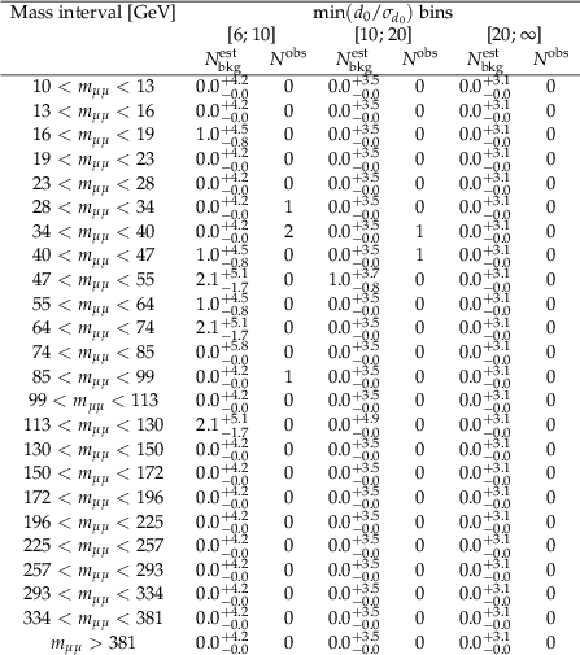
png pdf |
Additional Table 2:
Background estimations and observed numbers of events in the TMS-TMS dimuon category in 2016 data. The mass interval is followed by the estimated and observed counts within each min(d0/σd0) bin in this mass interval. The quoted uncertainties are statistical only. |

png pdf |
Additional Table 3:
Background estimations and observed numbers of events in the TMS-TMS dimuon category in 2018 data. The mass interval is followed by the estimated and observed counts within each min(d0/σd0) bin in this mass interval. The quoted uncertainties are statistical only. |

png pdf |
Additional Table 4:
Correspondence between the mass intervals in the TMS-TMS category and the parameters of the simulated signal samples. |
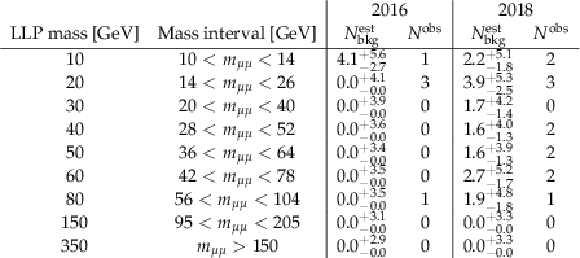
png pdf |
Additional Table 5:
Background estimation and observed number of events in the STA-TMS dimuon category in 2016 and 2018 data. For each probed LLP mass, the chosen mass interval is shown. The mass interval is followed by the estimated and observed counts for the given year. The quoted uncertainties are statistical only. |
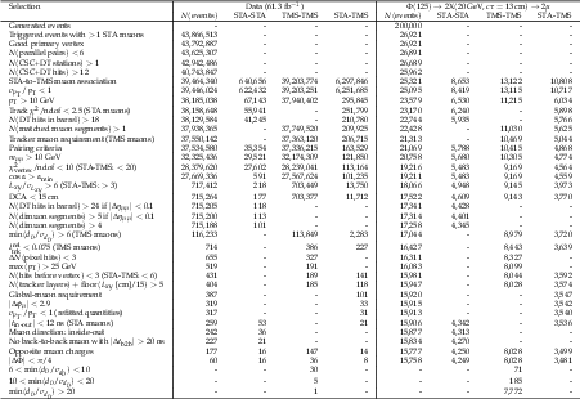
png pdf |
Additional Table 6:
Number of events passing consecutive sets of selection criteria for 2018 collision data and the signal process Φ(125)→2X(20GeV,cτ=13cm)→2μ. Each row introduces a new criterion that is applied in addition to the selection of the previous row. In addition to the total number of events, N(events), the event yields of the individual dimuon vertex categories, STA-STA, TMS-TMS, and STA-TMS, are shown in separate columns for each data set. In these columns, events containing selected dimuons of different categories are independently counted for each category. |
| References | ||||
| 1 | R. Barbier et al. | R-parity violating supersymmetry | PR 420 (2005) 1 | hep-ph/0406039 |
| 2 | J. L. Hewett, B. Lillie, M. Masip, and T. G. Rizzo | Signatures of long-lived gluinos in split supersymmetry | JHEP 09 (2004) 070 | hep-ph/0408248 |
| 3 | T. Han, Z. Si, K. M. Zurek, and M. J. Strassler | Phenomenology of hidden valleys at hadron colliders | JHEP 07 (2008) 008 | 0712.2041 |
| 4 | D. Curtin, R. Essig, S. Gori, and J. Shelton | Illuminating dark photons with high-energy colliders | JHEP 02 (2015) 157 | 1412.0018 |
| 5 | M. J. Strassler and K. M. Zurek | Discovering the Higgs through highly-displaced vertices | PLB 661 (2008) 263 | hep-ph/0605193 |
| 6 | CMS Collaboration | Search for long-lived particles that decay into final states containing two electrons or two muons in proton-proton collisions at √s= 8 TeV | PRD 91 (2015) 052012 | CMS-EXO-12-037 1411.6977 |
| 7 | CMS Collaboration | Search for long-lived particles that decay into final states containing two muons, reconstructed using only the CMS muon chambers | CMS-PAS-EXO-14-012 | |
| 8 | ATLAS Collaboration | Search for long-lived particles in final states with displaced dimuon vertices in pp collisions at √s= 13 TeV with the ATLAS detector | PRD 99 (2019) 012001 | 1808.03057 |
| 9 | CMS Collaboration | Performance of the CMS muon detector and muon reconstruction with proton-proton collisions at √s= 13 TeV | JINST 13 (2018) P06015 | CMS-MUO-16-001 1804.04528 |
| 10 | CMS Collaboration | The CMS experiment at the CERN LHC | JINST 3 (2008) S08004 | CMS-00-001 |
| 11 | CMS Collaboration | Performance of the CMS Level-1 trigger in proton-proton collisions at √s= 13 TeV | JINST 15 (2020) P10017 | CMS-TRG-17-001 2006.10165 |
| 12 | CMS Collaboration | The CMS trigger system | JINST 12 (2017) P01020 | CMS-TRG-12-001 1609.02366 |
| 13 | CMS Collaboration | Precision luminosity measurement in proton-proton collisions at √s= 13 TeV in 2015 and 2016 at CMS | Submitted to EPJC | CMS-LUM-17-003 2104.01927 |
| 14 | CMS Collaboration | CMS luminosity measurements for the 2018 data-taking period at √s= 13 TeV | CMS-PAS-LUM-18-002 | |
| 15 | J. D. Wells | How to find a hidden world at the Large Hadron Collider | in Perspectives on LHC Physics, G. Kane and A. Pierce, eds., World Scientific | 0803.1243 |
| 16 | J. Alwall et al. | The automated computation of tree-level and next-to-leading order differential cross sections, and their matching to parton shower simulations | JHEP 07 (2014) 079 | 1405.0301 |
| 17 | T. Sjostrand et al. | An Introduction to PYTHIA 8.2 | CPC 191 (2015) 159 | 1410.3012 |
| 18 | M. Cepeda et al. | Report from Working Group 2: Higgs Physics at the HL-LHC and HE-LHC | CERN Yellow Reports CERN-2019-007 | 1902.00134 |
| 19 | J. Butterworth et al. | PDF4LHC recommendations for LHC Run II | JPG 43 (2016) 023001 | 1510.03865 |
| 20 | CMS Collaboration | Event generator tunes obtained from underlying event and multiparton scattering measurements | EPJC 76 (2016) 155 | CMS-GEN-14-001 1512.00815 |
| 21 | NNPDF Collaboration | Parton distributions from high-precision collider data | EPJC 77 (2017) 663 | 1706.00428 |
| 22 | CMS Collaboration | Extraction and validation of a new set of CMS PYTHIA8 tunes from underlying-event measurements | CMS-GEN-17-001 1903.12179 |
|
| 23 | GEANT4 Collaboration | GEANT4: A Simulation toolkit | NIMA 506 (2003) 250 | |
| 24 | CMS Collaboration | Performance of CMS muon reconstruction in pp collision events at √s= 7 TeV | JINST 7 (2012) P10002 | CMS-MUO-10-004 1206.4071 |
| 25 | R. Fruhwirth | Application of Kalman filtering to track and vertex fitting | NIMA 262 (1987) 444 | |
| 26 | T. Speer et al. | Vertex Fitting in the CMS Tracker | CMS-NOTE-2006-032 | |
| 27 | R. D. Cousins, J. T. Linnemann, and J. Tucker | Evaluation of three methods for calculating statistical significance when incorporating a systematic uncertainty into a test of the background-only hypothesis for a Poisson process | NIMA 595 (2008) 480 | physics/0702156 |
| 28 | CMS Collaboration | Search for new particles decaying to a jet and an emerging jet | JHEP 02 (2019) 179 | CMS-EXO-18-001 1810.10069 |
| 29 | A. L. Read | Presentation of search results: The CLs technique | JPG 28 (2002) 2693 | |
| 30 | T. Junk | Confidence level computation for combining searches with small statistics | NIMA 434 (1999) 435 | hep-ex/9902006 |
| 31 | CMS Collaboration | Documentation for the Higgs Combine Tool | \url http://cms-analysis.github.io/HiggsAnalysis-CombinedLimit | |
| 32 | The ATLAS Collaboration, The CMS Collaboration, The LHC Higgs Combination Group | Procedure for the LHC Higgs boson search combination in Summer 2011 | CMS-NOTE-2011-005 | |
| 33 | CMS Collaboration | Search for invisible decays of a Higgs boson produced through vector boson fusion in proton--proton collisions at √s= 13 TeV | PLB 793 (2019) 520 | CMS-HIG-17-023 1809.05937 |
| 34 | CMS Collaboration | Combined measurements of Higgs boson couplings in proton-proton collisions at √s= 13 TeV | EPJC 79 (2019) 421 | CMS-HIG-17-031 1809.10733 |
| 35 | CMS Collaboration | Search for long-lived particles decaying into muon pairs in proton-proton collisions at √s= 13 TeV | Submitted to JHEP | CMS-EXO-20-014 2112.13769 |

|
Compact Muon Solenoid LHC, CERN |

|

|

|

|

|

|